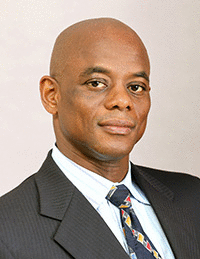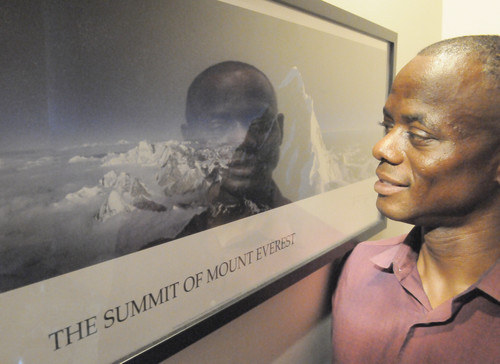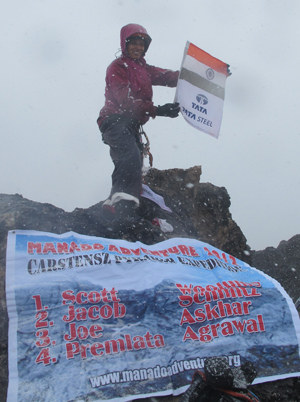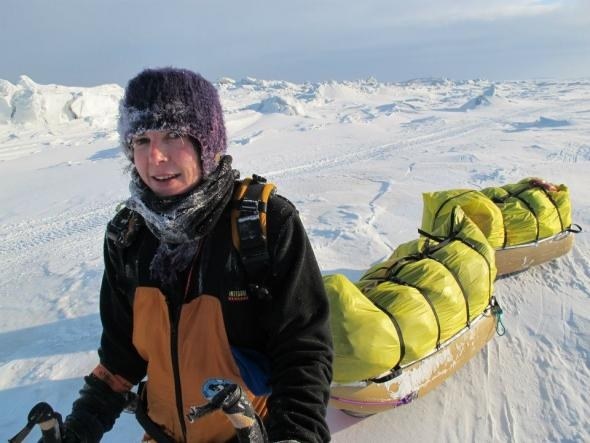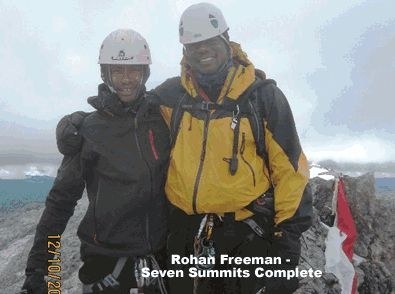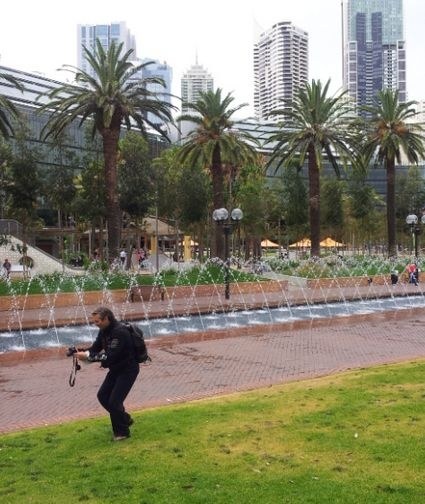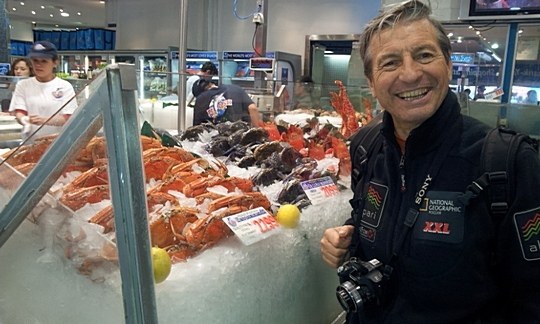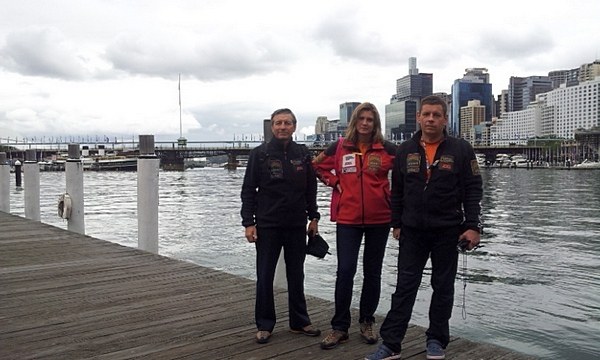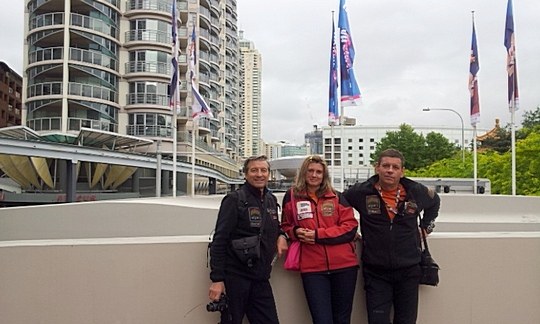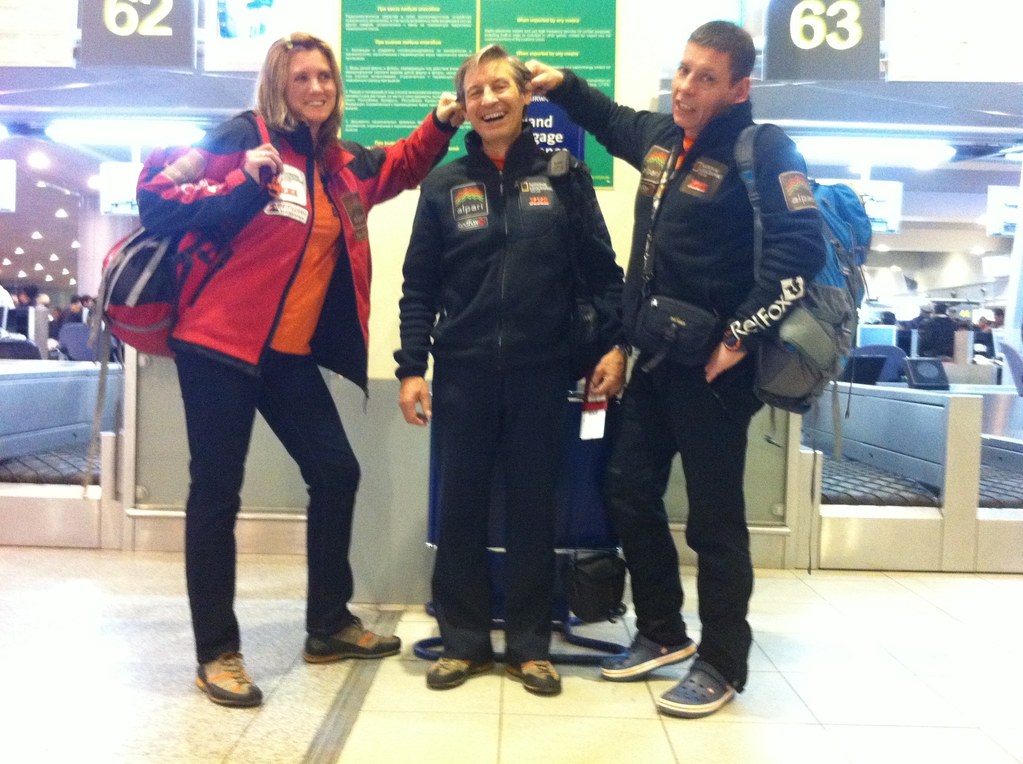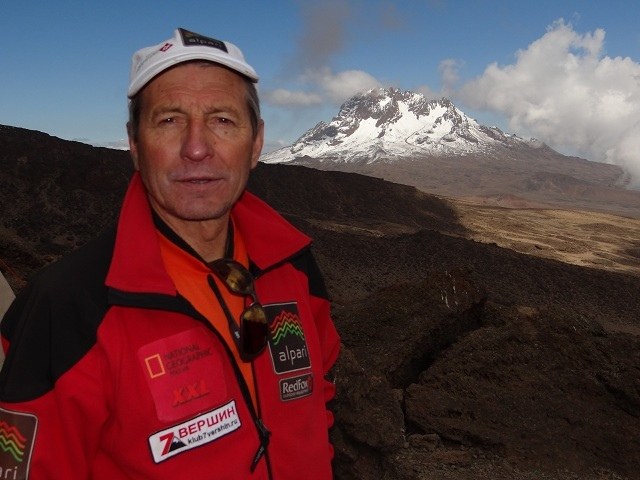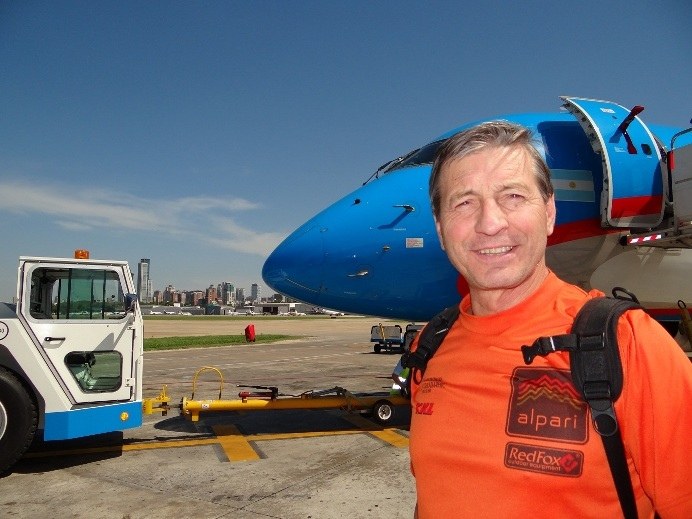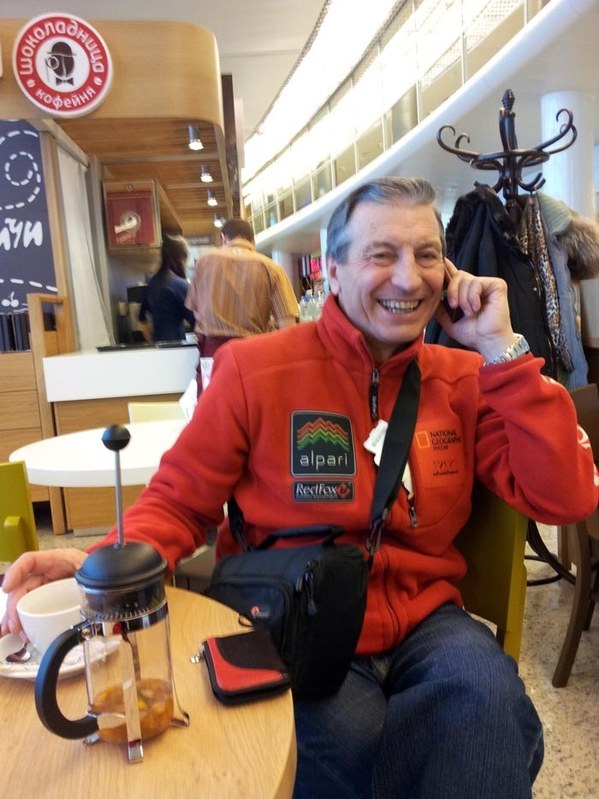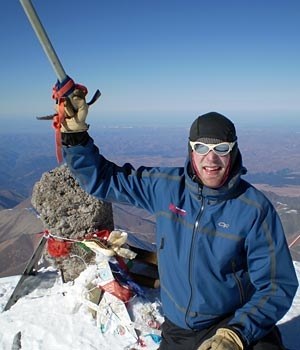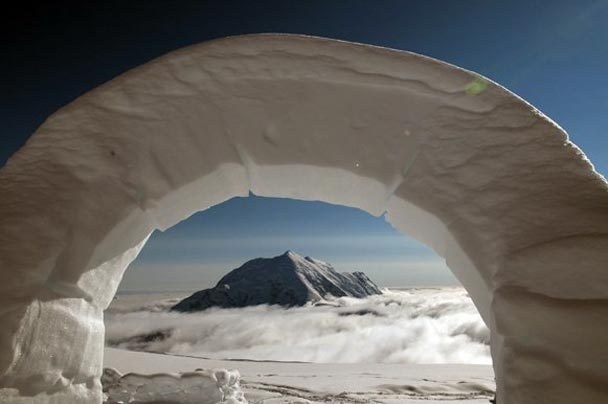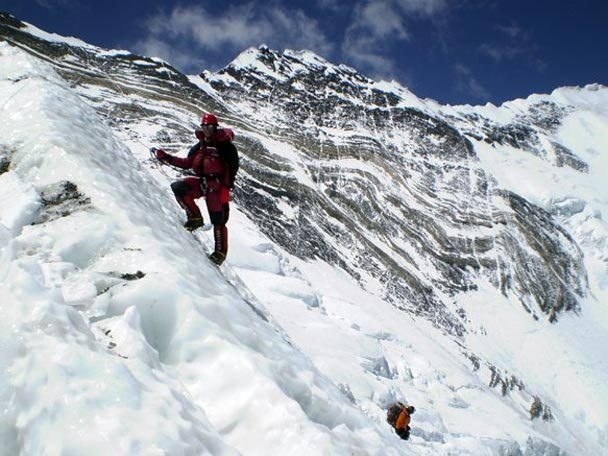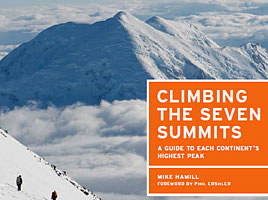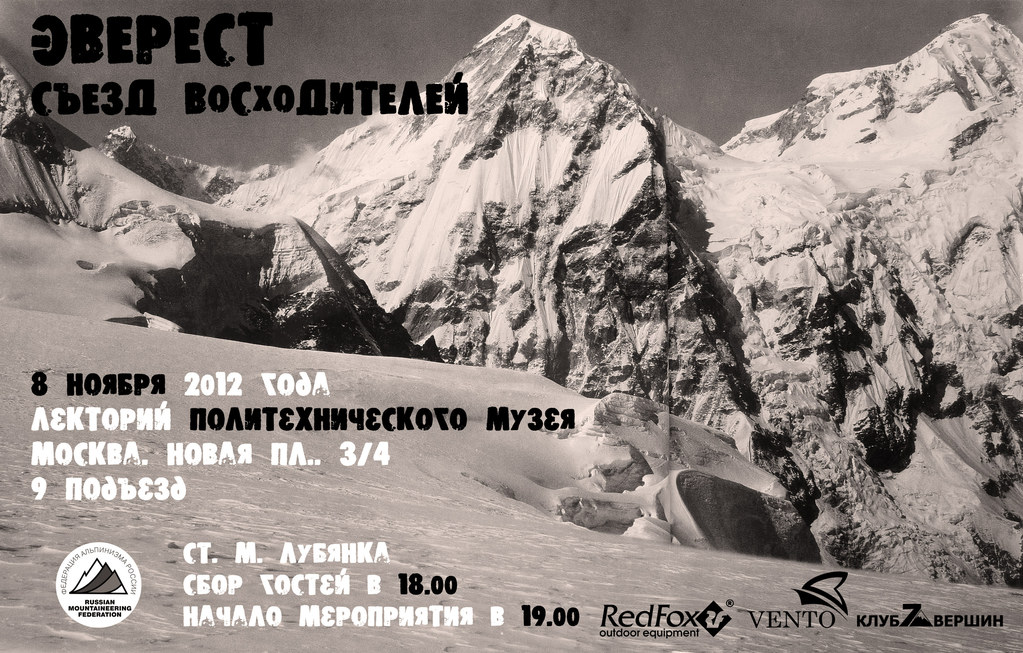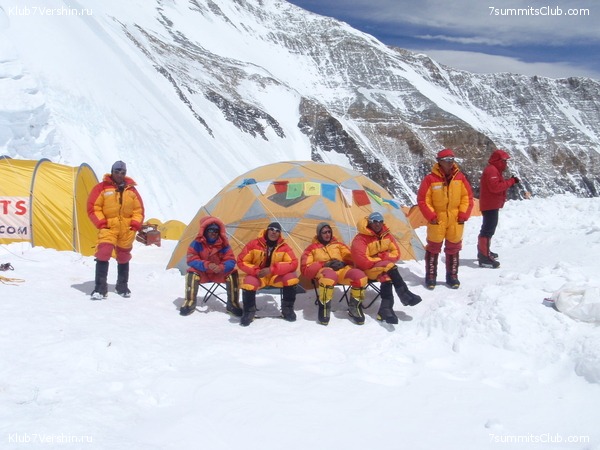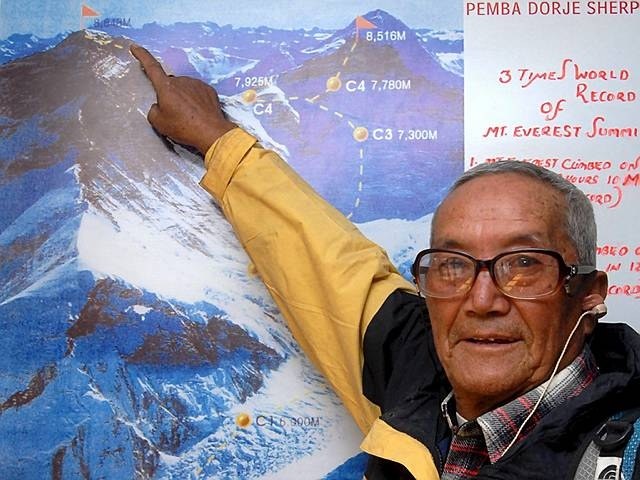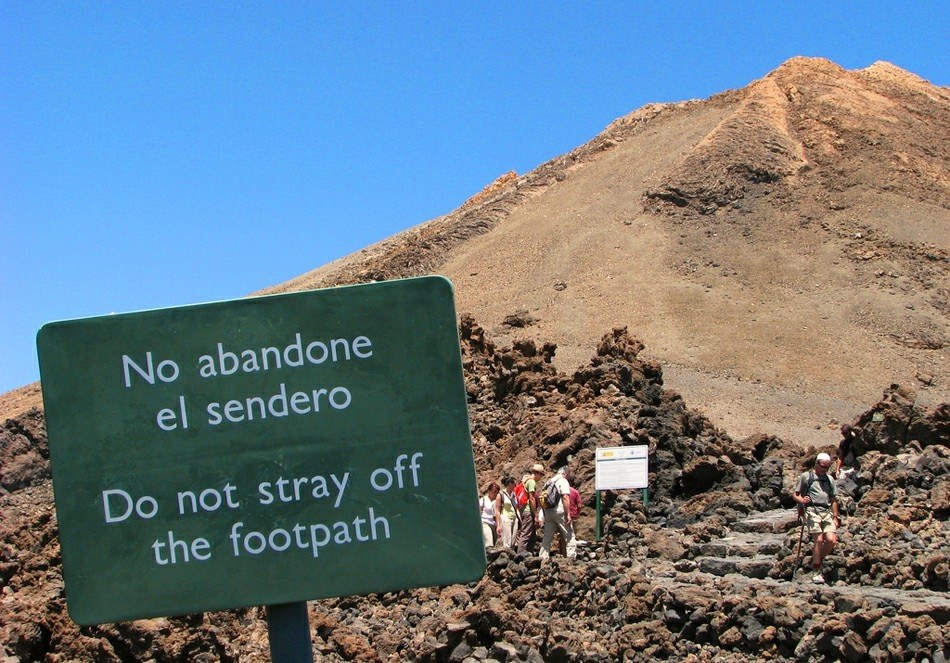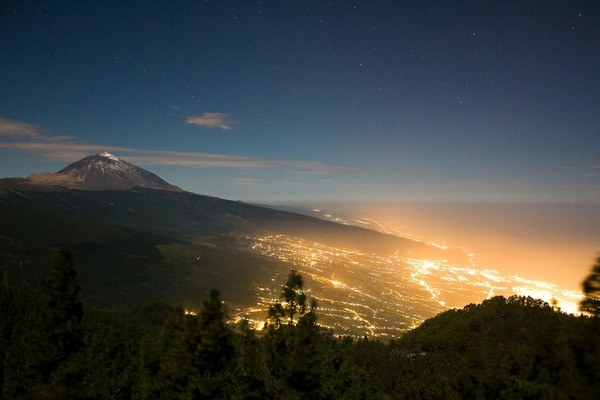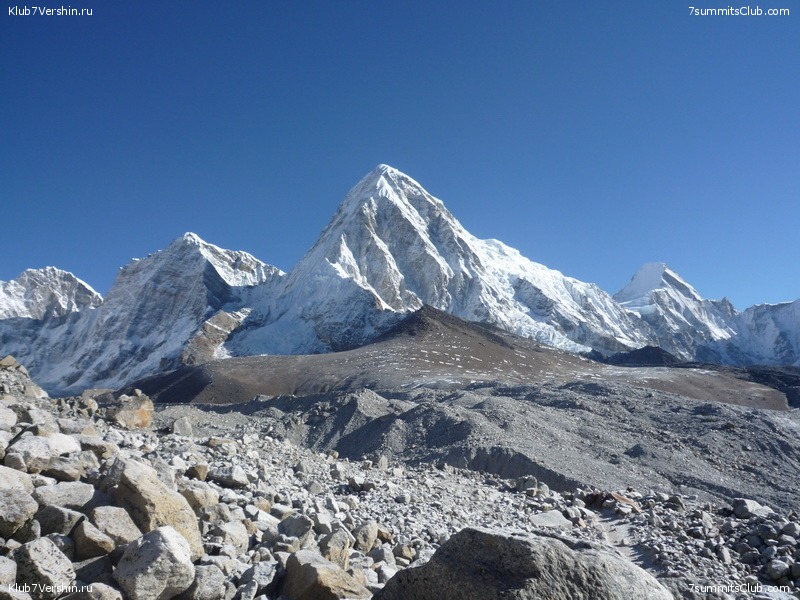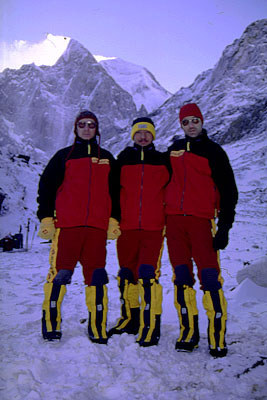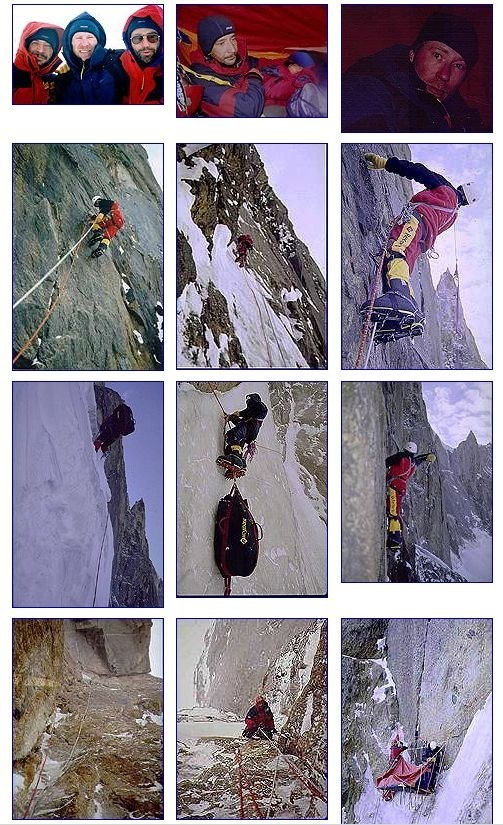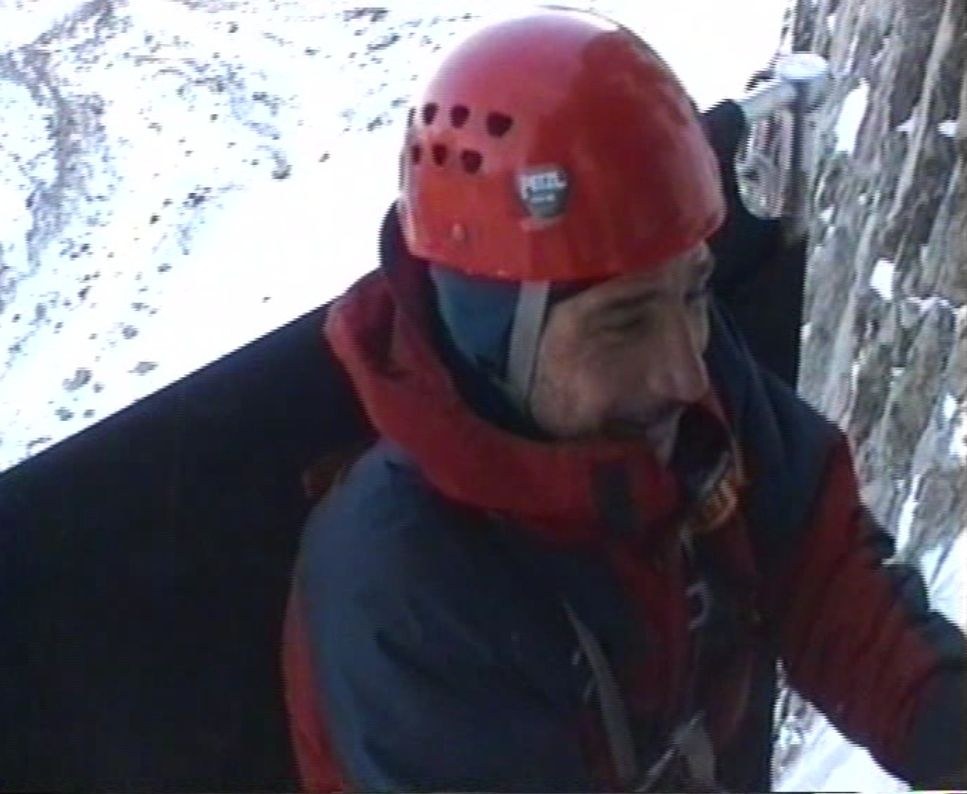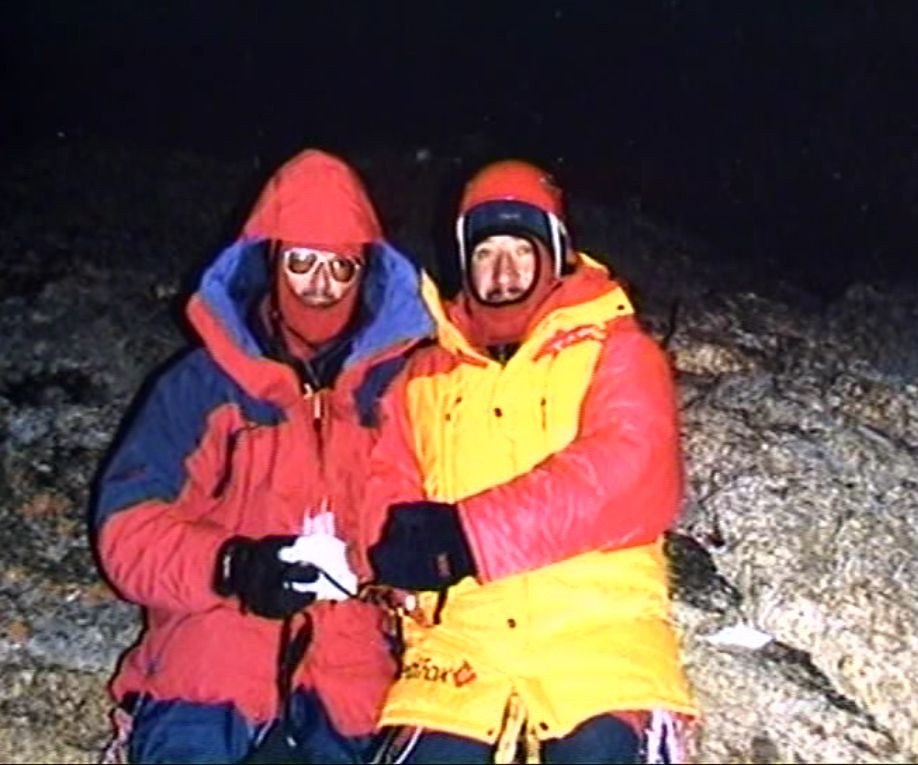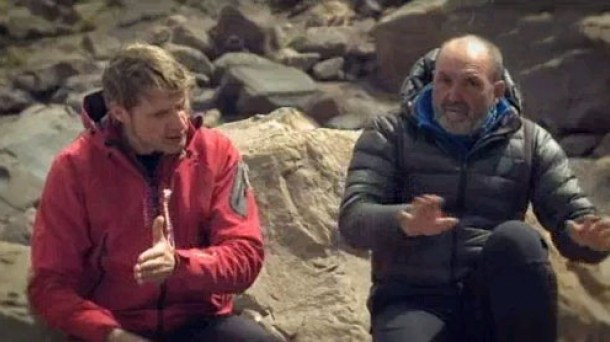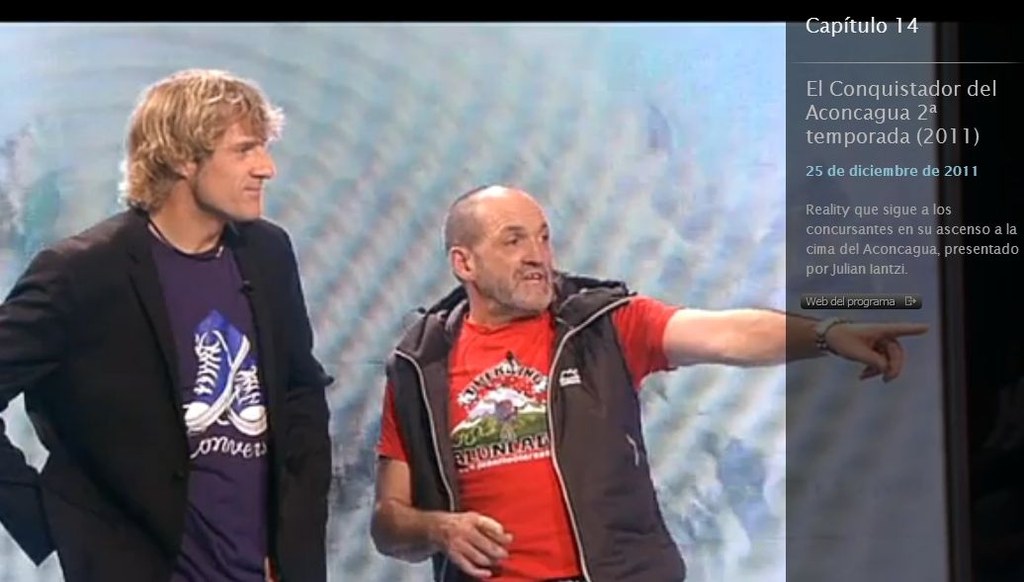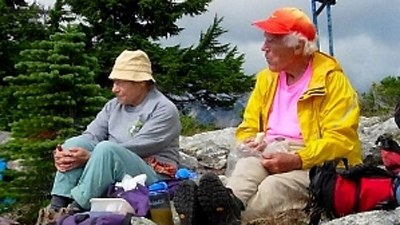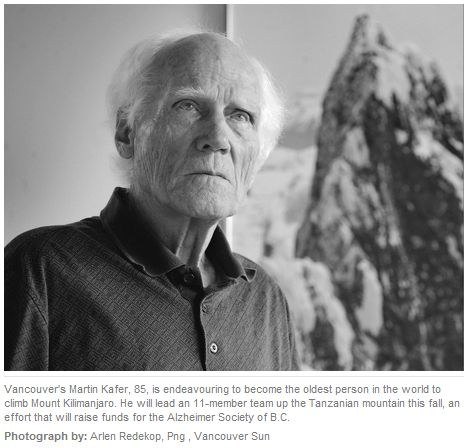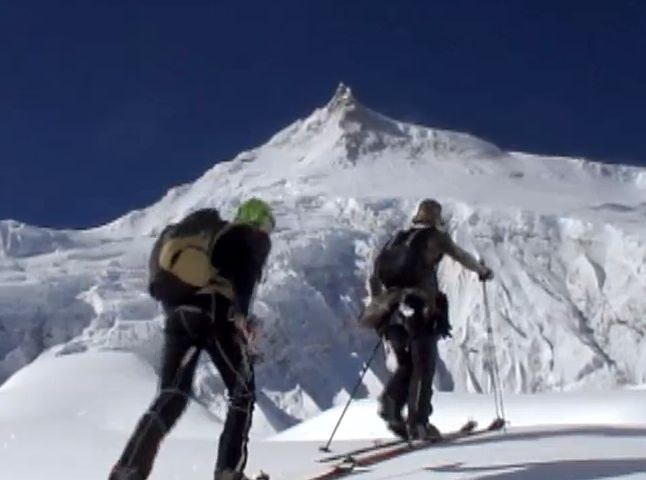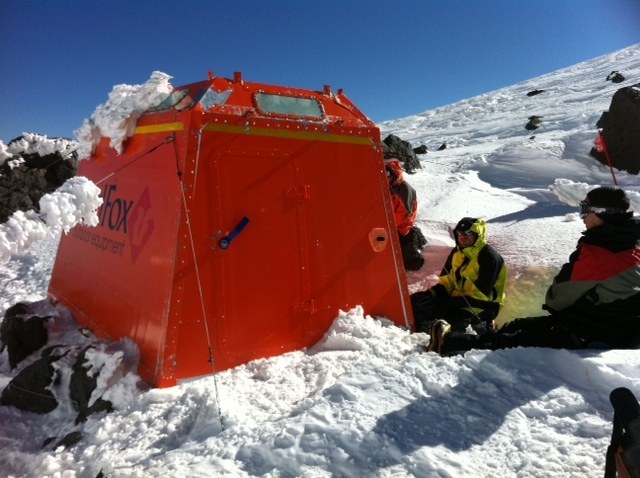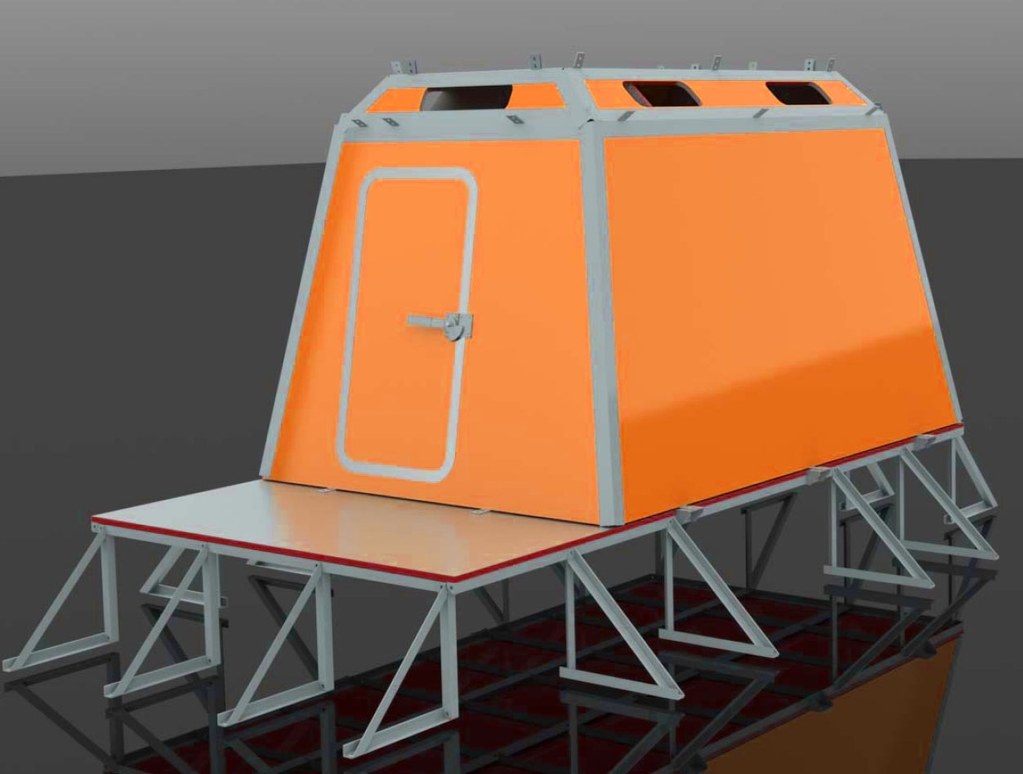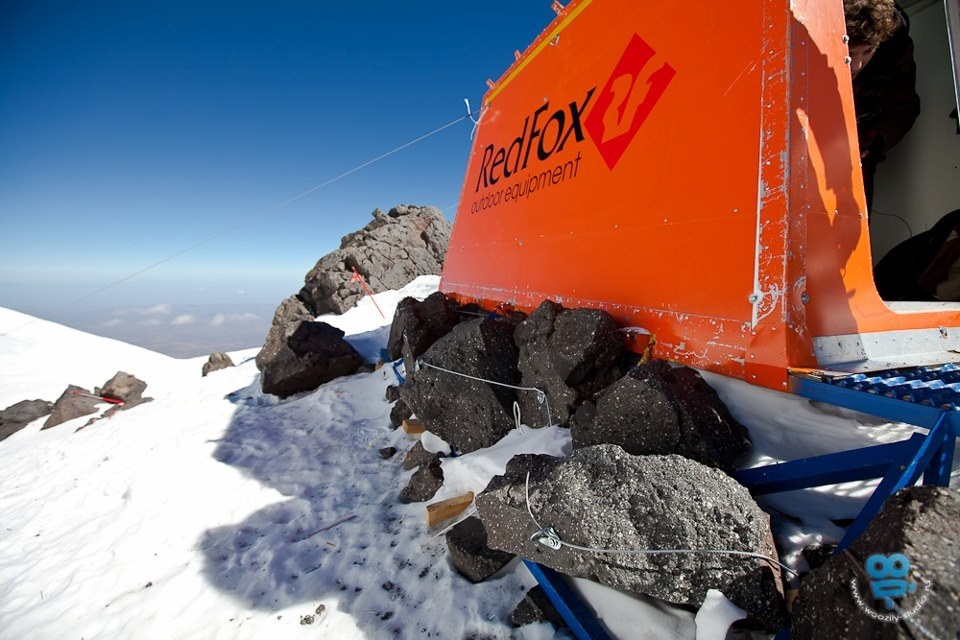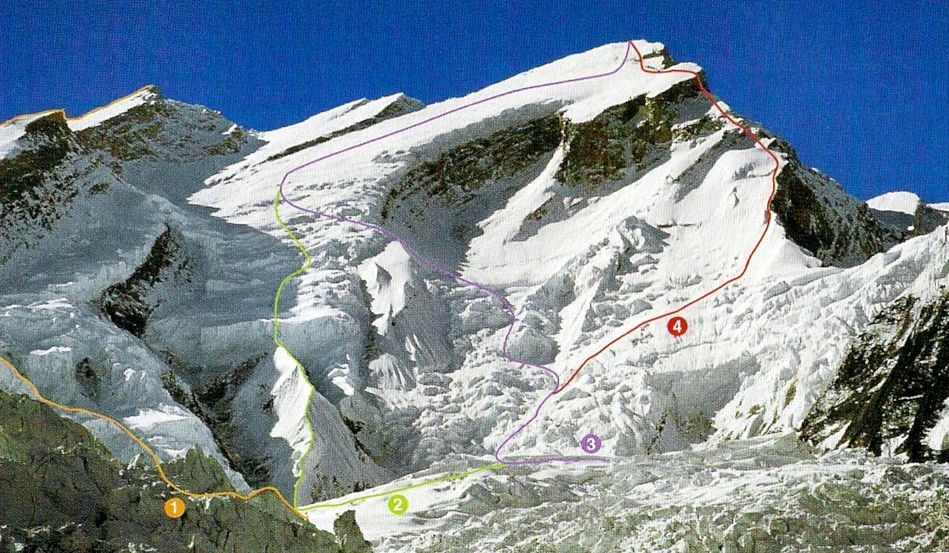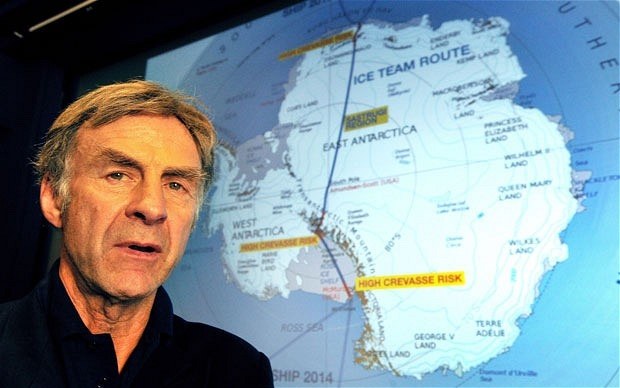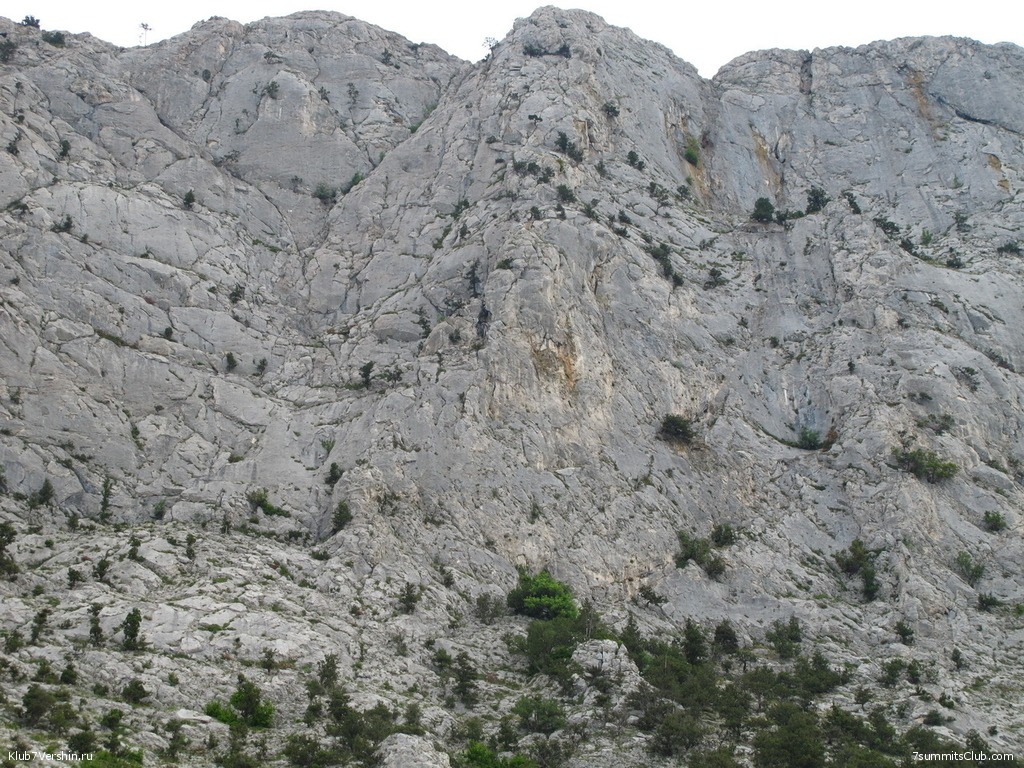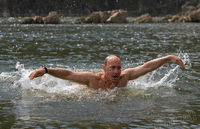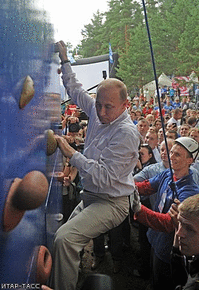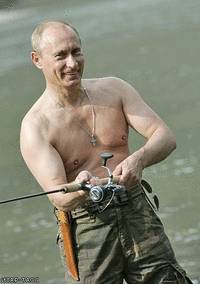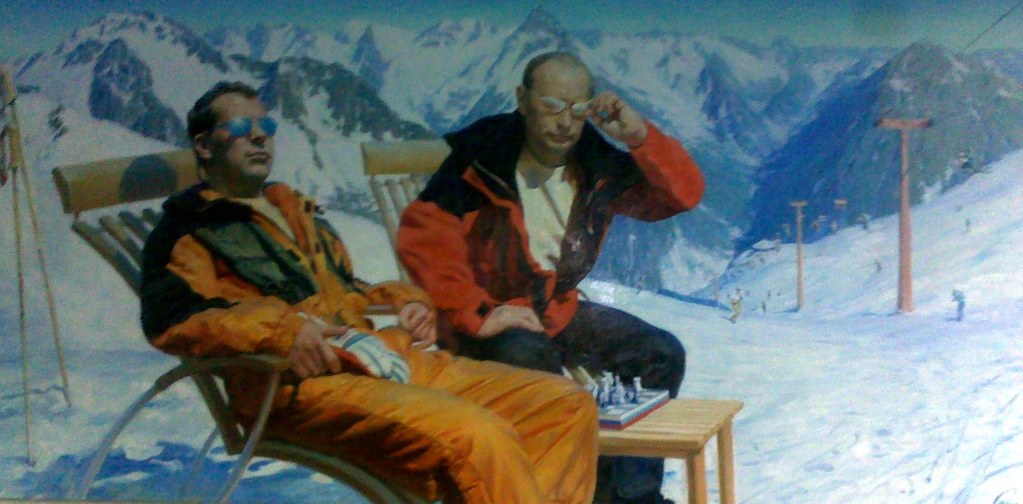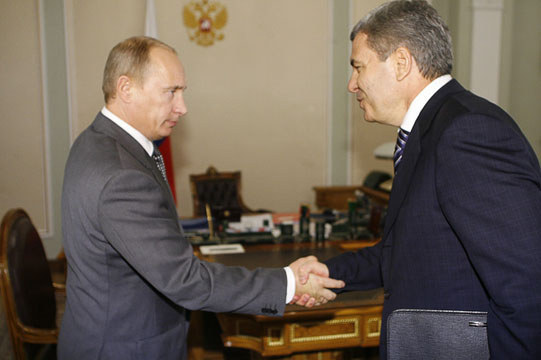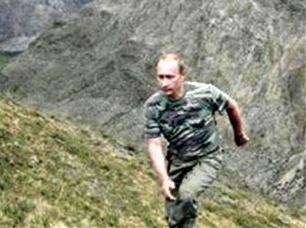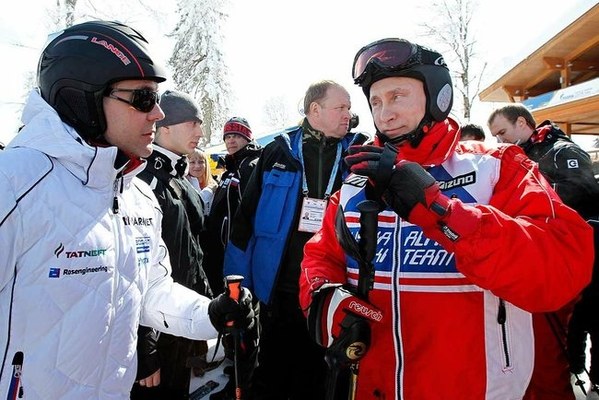All news: 2012
A group of Dmitry Ermakov climbed Kala Patar
Dmitry Ermakov, Alexei Bautin and Sergei Borisov stay on the top of Kala Patara. “Just 10 minutes ago we were on the top, we are now on the way down. The weather is beautiful, the mood is great. The first part of our journey is ...
Dmitry Ermakov, Alexei Bautin and Sergei Borisov stay on the top of Kala Patara. “Just 10 minutes ago we were on the top, we are now on the way down. The weather is beautiful, the mood is great. The first part of our journey is made”.
Seven Summits collectors’ stories
Vinson.
Rohan Freeman – the first Afro-American and Jamaican on the Seven Summits. In April 2009, Rohan Freeman embarked on an incredible journey to accomplish his dream of summitingMount Everest. In May 2009, he reached the ...
Rohan Freeman – the first Afro-American and Jamaican on the Seven Summits.
In April 2009, Rohan Freeman embarked on an incredible journey to accomplish his dream of summitingMount Everest. In May 2009, he reached the world’s highest peak. In June 2009, he returned home with his sights set on establishing his own engineering consulting firm.
Mr. Freeman was born and raised in Jamaica, and came to the University of Connecticut to explore his interests in the field of civil engineering. He went on to become a dually licensed Professional Engineer and Land Surveyor. His innate leadership talents and project management abilities have been enriched by his 25 year career in the industry working for nationally recognized firms, as well as the City ofHartford’s Public Works Department.
He is a man that is characterized by his passions, pride and drive. He embodies the spirit, culture and values of his firm. The establishment of Freeman Companies has been a challenging and exciting accomplishment, and Mr. Freeman is excited about the future success and the endless possibilities that lie ahead. Failure is not an option.
Rohan’s summit ofMount Everestis part of his larger initiative to summit the highest peak on each of the world’s seven continents. His conquest ofMount Everestmarked the fifth of his seven summits. He climbed in support of the Boys & Girls Clubs of Hartford, and has served as an active member of the organization’s Board of Directors since 2008.
A former track star at the University of Connecticut, Freeman said he first wanted to climb mountains in 1998, when he booked his first vacation to a winter resort. One winter sport led to another, he said, and in June 2002, Freeman and several friends climbed Tanzania's Mount Kilimanjaro, Africa's highest mountain. He then scaled three of the other "Seven Summits" -MountMcKinleyinAlaskain June 2004, Mount Elbrus inRussiain June 2006 and Aconcagua inArgentinain December 2006 - before he attempted to climbMount Everest.
"Just the idea that he's done outreach and work with the youth of Hartfordand has shown them a much broader world ... that was very important [to us]," said fund President Kirk Sykes.
After Everest Freeman climbed the last two of the "Seven Summits": Vinson Massif in Antarctica and Mount Kosciuszko in Australia- in 2010. And finished this story climbed Pyramid Carstensz in fall 2012.
"When I returned from Everest, I stared my own engineering company," Freeman said. "I'm trying to see if I can make that a success."
Premlata Agarwal
Premlata Agarwal has added yet another mountain to her kitty! The oldest Indian woman mountaineer to have scaled Mt Everest has now also become the only Indian woman to climb Carstensz Pyramid, the highest peak of the Australia/Oceania continent, which is deemed one of the most difficult to climb.
Talking to mediapersons on her return, Agrawal (48) said she reached the 16,024-feet steep Carstensz summit ofIndonesiaon October 23, after seven days of trekking. She has now scaled five of the seven highest summits of all continents.
She took a tumble innumerable times during the expedition, braved consistent rainfall and slipped on slushy tracks to the base camp. “It was a very difficult and challenging climb. Several elements came across our trek but we did not lose heart. But I’m very happy to have come back successful,” she said.
It rained throughout the journey, in which she had threeUSmen climbers as part of the team. “We flew into Timika fromBalion October 15. Then we took a hour-long flight to Sugada village, which is one of the openings to the base camp,” Premlata recalled.
This resident ofJamshedpurwill go to Mt Vinson Massif (Antarctica) in December and re-tryMountMcKinley(North America) in May-June next year to complete her seven-summit campaign. She was forced to return without climbing McKinley last June due to inclement weather.
Agrawal has set sight on completing the mountaineering challenge of climbing the Seven Summits and Tata Steel is the proud sponsor of her expedition, and is supporting her with a sponsorship of Rs 80 lakh. Conquering all seven summits makes one a member of the Hall of Fame for mountaineers.
If Premlata achieves this remarkable feat — she is targeting 2013 for it — she will become the first Indian woman, and one the oldest in the world, to do so.
Antarctica's Tallest Peak
NASA’s DC-8 flying laboratory passes Antarctica’s tallest peak,MountVinson, on Oct. 22, 2012, during a flight over the continent to measure changes in the massive ice sheet and sea ice. The flight is part of NASA’s Operation IceBridge, a multi-year airborne campaign to monitor changes in Earth’s polar ice caps in both the Antarctic and Arctic. Ice Bridge science flights from Punta Arenas, Chile, began on Oct. 12 and continue through early November. Mount Vinsonis located in the Sentinel Range of the Ellsworth Mountains in Antarctica.
Dr. Clare O'Leary
She's already conquered Everest, completed the world's Seven Summits and become the first Irish woman to reach the South Pole.
But now Dr. Clare O'Leary is aiming to make history once again as part of the first Irish team to cross the perilous, but little-known North Patagonian Icecap.
The pint-sized adventurer, from Bandon, Co.Cork, is part of a five-strong team that also includes Kerry explorer Mike O'Shea, which is attempting to cross the treacherous 120km distance.
The team, which set off from their base inChilelast weekend, is expected to spend the whole of this month hauling their sledges across the remote cap, which has only ever been crossed by a handful of people.
Even preparing for the challenge and packing the correct clothing was a logistical nightmare, as temperatures, on altitudes ranging from 1200m to 1500m, can range from -30C to 30C on the same day.
Both Clare and Mike have spent months training for the gruelling adventure, which is deemed particularly challenging because of the difficulty in accessing the icecap.
The team will have to climb a towering glacier before setting foot on the cap, while the journey will also include boat trips, camping and horse riding with South American gauchos and crossing a rainforest.
Earlier this year both Clare and Mike were forced to abandon their bid to become the first expedition to make it to the North Pole.
They were forced to pull the plug on the challenge to reach the remote Arctic point, because their plan to share chartered logistics with other teams fell apart.
Clare is the first Irish female toclimbMt.Everest and also the first Irish woman to complete the Seven Summits, which includesMt.Vinsonin the Antarcticand Mt. McKinley inAlaska.
Keep track of their progress at irishnorthpole2013.com.
The Alpari team arrived in Sydney
Flight to Sydney was very tedious. The route was changed by airline and our team a long time was sitting inThailand, not knowing when will be allowed to fly further. Only after whole day on the road, Lyudmila Korobeshko, Ivan Dusharin and ...
Flight to Sydney was very tedious. The route was changed by airline and our team a long time was sitting inThailand, not knowing when will be allowed to fly further. Only after whole day on the road, Lyudmila Korobeshko, Ivan Dusharin and Maxim Shakirov arrived in Sydney. The first day was devoted to a sightseeing tour of this wonderful city.
Forecast Kosciuszko ...
Spring in theMountainsBlueMountainturned leisurely. Therefore, on the slopes longer than normal to save snow. Actually, all paths lead to the top, covered with snow. It, however, melts quite intensively. Moist, moderately warm weather contributes to this process. Each day will be at least a little rain, sometimes with the wind. In general, the picnic was not supposed to be.
http://www.thredbo.com.au/mountain/live-cams/
---------------------------------------------------------------------------------------------
Project “7 Summits for 300 days”
8th of September the team of Alpari Lyuda (Lyudmila) Korobeshko - Ivan Dusharin - Maxim Shakirov climbed theWestern Summit of Elbrus. It was their fifth mountain from the “big seven”. The most difficult ones – Mt Everest andMt.Denali were climbed in May and June 2012.Mt.Kosciuszko - the highest Australian hill is the next goal. It could not be difficult to climb it in November. The last one –MountVinson is waiting at the beginning of December. In recent years, the vast majority of those who arrive to climb theMountVinson, reach the top. So we have confidence that our target will be achieved.
“Alpari On Top of the World” project
It all started with a friendship with the leaders of the company of Alpari. Sometimes we go to the mountains together. In 2008, the leader of Alpari Andrey Dashin went with the 7 Summits Club inEcuador. It was his first trip to the mountains. Andrey felt interest in mountaineering and introduced it to his employees. Then there were Kilimanjaro, Alps,Tibet, Altai,Kamchatka. “It’s a good tradition. We all climb together, overcoming obstacles, cold weather, difficult conditions. But we make it,” commented Andrey Dashin.
During this visits it was burn an idea to raise the banner of Alpari the highest peaks of world.
The project’s goal is simple: climb the Seven Summits in just 300 days!
A bit more about Alpari:
Alpari is the world’s leading MetaTrader 4 broker, and, according to a recent report from “Forex Magnates”, one of the world’s three largest Forex brokers. In addition to online trading, Alpari offers a variety of other services including free analytical tools and partnership programs. Alpari has been providing online brokerage services for over 13 years, now with more than 540,000 accounts belonging to clients from 150 countries around the world. It is represented in more than 20 countries and more than 30 cities in Russia. It has earned the trust of clients and partners everywhere. Over the years, Alpari has racked up a number of prestigious financial awards, including one for being named the “Company of the Year in Forex” at the 2011 Financial Elite of Russia Awards.
The Team for Several Records
A team of experienced climbers will have to implement this idea. At the same time, managers of Alpari have to take part in several expeditions. The persons for the team of climbers was offered by the Mountaineering Federation of Russia after discussions with the 7 Summits Club.
Lyudmila Korobeshko is the captain of the team. She is the only Russian woman climbed Seven Summits and been to the North and South Poles (Last Degree).
Ivan Dusharin, 65 years old “patriarch of Russian alpinism”, is an internationally recognized climber with the supremely challengingK2, among many other impressive climbs, under his belt. He is a vice-president of the Mountaineering Federation of Russia.
Maksim Shakirov, author of “New Year on the Peaks” project, photograph and video operator, he is a well-known as “media-climber” who planted the flag of the 2014 Olympic Games atop Mount Everest and Mount Olympus.
Several records are planned to be broken if the team is successful:
- all-world speed record for women (Lyudmila Korobeshko);
- speed record for a team of three and more;
- age record for climbing 7 Summits in one year (Dusharin);
- first ever team to climb all Seven by non-standard route (not fulfilled yet, because the weather on Everest was unfavorable)
- several national records.
Ivan Dusharin anniversary coincided with the departure of the group
On the night of November 2, the team "Alpari on top of the world" has gone from Domodedovo airport inAustraliato climb the continent's highest peakMountKosciuszko. The mood was festive, because everyone continued to celebrate the ...
On the night of November 2, the team "Alpari on top of the world" has gone from Domodedovo airport inAustraliato climb the continent's highest peakMountKosciuszko. The mood was festive, because everyone continued to celebrate the anniversary (65 years) of Ivan Dusharin. And we jokingly remarked that one of the gifts was a birthdays "trip for three" inAustralia...
Our congratulations !
Ivan Dusharin. His official sporting status is master of sports of international class, “snow leopard”. He has been climbing mountains since 1964; 19 times summited 7,000m peaks of former USSR, also conquered Mont Blanc (1985), Aconcagua (1991, 2012), Everest (1992, 2005, 2012), McKinley (1995, 2012), Changabeng (1998), Nanga Parbat (1997), Cho Oyu (2002). While being younger Dusharin served in air-landed force, has a large number of parachute jumps. He is an engineer-designer by profession. Long time Ivan Dusharin was the head of the robot design bureau at AvtoVAZ plant. Now he lives inMoscowand work as a vice-president of the Russian Mountaineering Federation.
Ivan Dusharin
http://www.ageofhappiness.com/blog/ivan_dusharin_eng/234/
Sixty-five year-old Ivan is a mountain climber. Ivan Dusharin has decided to vanquish all of the tallest peaks in the world within one year. Over the past six months, Dusharin has already surmounted Kilimanjaro, Everest and Aconcagua. And during the next half year, he intends to climb another four of the world’s peaks. The idea is to climb to the highest points in each of the seven continents. At the end of May, Ivan descended from Everest and on the next day, following the photo shoot for The Age of Happiness project, he took off to triumph over McKinley, the highest point inNorth America.
No one inEuropehas ever climbed seven peaks in one year. For world mountain climbing, this is a significant project, considering that Dusharin and two colleagues on his team, Lyudmila Korobeshko and Maksim Shakirov, are deliberately avoiding the classical routes and choosing complicated paths for the climb.
That climb on Everest was Ivan Dusharin’s third. It took 59 days. «The temperature this time was good,» says Dusharin, only −45 c." And he recalls that the time before, he was less lucky. Then it was −54 c." True, this time the «good» temperature bestowed upon him lightly frostbitten fingers, as he had to take off his gloves in order to take pictures at the peak.
When Dusharin was 50, he climbed Changabang, the Indian peak, in such a way that no one had ever managed to do it previously—on the sheer face. The climb up the vertical wall lasted 16 days without a break, spending the nights on the face, as well, three of them hanging in a tiny piece of stretched tarpaulin.
How can you stand it? Ivan avers that the secret lies in relaxing. When you are able to relax your body properly, you can manage to rest even if you are hanging by one hand. Dusharin eagerly demonstrates how, exactly.
During hard climbs of many days, Ivan loses a lot of weight. On his last Everest ascent, he lost nearly 10 kilos. «Ordinary athletes have a body build,» he jokes. «But we mountain climbers have a body demolition.»
Dusharin’s method of weight loss is, of course, one of the most effective, but is also inhumanly arduous. Actually, with regard to mountain climbing, Ivan himself doesn’t value the ability to demonstrate physical endurance as much as the need to contemplate and make a decision. «This is a genuinely intellectual sport,» he says. «You have to think a lot.»
--------------------------------------------------------------------------------------
Ivan’s Early Years
I was born in 1947 in Pokhvistnevo, a small town in the south ofRussiawhose name was borrowed from the nearbyvillageofOld Pokhvistnevo. As a child, I was interested in the origins of the name of my hometown. As it turned out, Lieutenant Pokhvistnev served under one ofRussia’s most celebrated military heroes, Field Marshal Mikhail Kutuzov. For his bravery and valor during the French invasion ofRussiain 1812, Pokhvistnev was awarded an estate in the Simbirkskiy province. The estate no longer remains, but the lieutenant’s name lives on as the name of two towns.
Life after WWII, especially outside of the big city, was difficult and humbling. Just getting hold of a loaf of bread meant standing in huge lines. The horror of fighting over bread crumbs is something that will be forever ingrained in my memory. I was probably 6 years old when I was trampled in a bread line. I was holding onto my mother as we slowly moved into the store. I remember the legs and feet around me, the bodies, the stuffy air, the cries I heard as we scrambled to get our share of bread. I was getting squeezed harder and harder, then darkness… I woke up, lying in the snow. Some woman wiped snow off of my face. “Thank God! He’s awake,” she said to me as she stood me on my feet. “Stand and wait for your mother,” said my savior as she disappeared into the crowd. I sat down in the snow. I could not stand. Everything hurt. It was difficult to breathe. I stared at the crowd of people squeezing into the store, not understanding what was going on and what had just happened to me. I don’t remember how much time had passed by the time my mother emerged from the crowd, her hair undone, her shawl in her hands, her face bright red. She looked horrible, yet satisfied. She was holding two small loaves of dark bread to her chest. She ran to me and said, “Thank God! And they gave you bread too. They took pity seeing how close you made it to the counter.” She wasn’t as interested as I was? I was alive and moving, so everything was okay to her. What about me losing consciousness? I guess I was not the only one. That was a pretty common thing in the bread line.
My mother fixed her clothing and we headed home. I still felt terrible, but I remained silent, trailing behind my mother. I was indifferent to the world around me, but I could see my mother was happy. We managed to bring home 2 loaves of bread for the family. Just knowing that I helped was enough to bring me back to full strength. This was how I spent my childhood: fighting for bread crumbs, gathering sorrels to make pies, picking berries and mushrooms, collecting hay for the goat. The children of the post-war period lived through difficult conditions, but the struggle to survive made us tougher. We grew up to be unpretentious, adaptable and resilient. We didn’t think of ourselves as unlucky or as having been dealt a bad hand by Fate. School.. I remember my school days, being around people much like myself; friends and comrades. I remember true friendship, training to be a pinko communist, speaking with wise and caring people – my teachers. Many of them taught us not only their subject matter, but important life lessons as well. Thank you to all of them!
I studied at a mechanical engineering school in Samara. It was a different atmosphere, a different type of school. I found myself mixed in with teenagers from the big city, from more advantaged families. My peers from the countryside were looked down on as outsiders, like people with a lower social status. The boys and girls who weren’t from Samara quickly began to understand how things worked and started to band together. In life, like attracts like. We were dressed more modestly. We ate poorly. We wouldn’t allow ourselves extra. We didn’t quite feel at home in the big city. But our persistence, our sense of fairness, our hard work and physical conditioning forced them to respect us and consider our opinion. In our studies, especially in practical subjects, we quickly overtook our fellow students from the big city. It was during this time, a period of self-affirmation and soul-searching, that I discovered parachuting, and more importantly, I was introduced to the mountains.
In January of 1964, I had my first taste of mountain climbing. By 1967, I was already enrolled in a school for future mountain climbing instructors. The mountains are a truly remarkable part of nature, a place where the bonds of friendship are formed. They are a place for personal struggle and maturation, where you learn about the world, yourself and everything that surrounds you. Everything was unusual, but it was amazing. I found myself surrounded by great people. Some of my teachers were: Svetopar and Kamille Koroleva, Vitaliy Abalakov, Vladimir Kizel, Yakov Arkin, Grigoriy Maslov, Ilya Martinov and many other terrific people, who helped us appreciate the beauty and the grandeur of the mountains. These were people of the highest intellect, who looked to share their personal knowledge and experience with us, who taught us to see and to love beauty, nature and life. Mountain climbing during that time, and with those people, was a world-class learning ground and I was fortunate to be a part of it. It had a powerful impact on my life.
Serving in the army is a special period in life, one that every man remembers. I was fortunate. My time in the army was difficult, but interesting as well. I served as a paratrooper in the Baltics, starting out in a heavy paratrooper equipment battalion. My technical education and my physical training came in handy. I graduated from my training unit with honors. Unexpectedly, I was sent to courses to become a Komsomolskiy paratrooper instructor. I had a lot of work, but it was interesting. The knowledge and skills I picked up from mountain climbing lessons came in handy. It was not a fool that said, “Never stop learning. Anything you learn might turn out to be useful.” After 11 months of service, I was made first sergeant, the highest possible rank for compulsory service. With some difficulty, I managed to get out of the army, although my commanding officers told me I should stay, that I had a great career ahead of me. But the mountains were calling me. In May of 1970, I returned to Samara, found some work, and left for the mountains. I came back from the mountains just in time to register for night classes. Life suddenly became more rigorous: work, school, sports.
Èñòî÷íèê: http://www.alpari-life.ru/en/ivan_dusharin/
Ivan Dusharin
Climbing the Seven Summits: Up and down the world's highest peaks
By Terry Wood. Special to The SeattleTimes About. Mike Hamill is a professional mountain guide, writer, and photographer. He regularly leads expeditions to the mountains of the Seven Summits, among others, and has climbed all ...
By Terry Wood. Special to The SeattleTimes
About. Mike Hamill is a professional mountain guide, writer, and photographer. He regularly leads expeditions to the mountains of the Seven Summits, among others, and has climbed all of the original Seven Summits at least four times, some as many as twenty. He has climbed them all in the course of one year several times, finishing them in 2008 in 220 days, the tenth fastest time to date. Mike was featured in the Discovery Channel’s television production entitled Everest: Beyond the Limits.
Mike has been guiding for more than a decade and callsSeattlehome when not on the road. He began his climbing career on the steep rock and ice of New England andNew YorkStatewhile obtaining a bachelor of science from St. Lawrence University inCanton,New York. He hails originally fromHanover,New Hampshire, andBridgton,Maine.
http://climbingthesevensummits.com/
Mike Hamill is part of an exclusive club, one of about 350 people who have climbed the highest peaks on all seven continents.
Hamill, 35 — a Maine native now with a West Seattle home address — has stood on top of each summit at least four times: four ascents of Mount Everest (29,035 feet), nine of Alaska's Denali (20,320 feet) and 19 ascents of Argentina's Mount Aconcagua (22,841 feet).
Figuring he knows the territory, Hamill has written "Climbing the Seven Summits" (The Mountaineers Books, 352 pp., $29.95), which outlines the details involved in reaching each continental high point, from Australia's Mount Kosciuszko (7,313 feet) to Antarctica's icy 16,050-foot Vinson Massif.
Hamill actually describes eight peaks, since some argue thatIndonesia's 16,024-foot Carstensz Pyramid, 60-plus miles off Australia's north coast (but part of the same continental shelf), is a preferred alternative to Kosciuszko. His book devotes a chapter to that debate alone.
A guide for International Mountain Guides inAshford,Wash., Hamill fielded a few questions in advance of his Sunday appearance at Wallingford's Wide World Books & Maps:
Q: Which summits stand out to you?
A: The two climbs I enjoy the most are Vinson Massif andDenali. Vinson is a truly unique experience. The remoteness and vastness of the continent are like nowhere else on Earth. The Alaska Range is an incredibly beautiful place, andDenaliis my excuse for getting back there each summer. The people are amazing, and there's such an energy in the summer from the sun never setting.
Of course, there's no feeling like walking down theKhumbuValleyinNepalafter a successfulMount Everestclimb.
Q: Can you pinpoint a common trait among people drawn to this goal?
A: They're goal-oriented, motivated people. They climb for a variety of different reasons, but the common thread is that they all enjoy working hard and attaining a goal that takes a lot of work and tenacity to reach.
Some are serious climbers, while others are people who began pursuing climbing to see the world and experience unique cultures. I've climbed with people from all walks of life and have had the pleasure of sharing these mountains with some of the most unique people on Earth.
Q: The hardest?
A: Mount Everest, followed by Denali,Aconcagua, Vinson, Carstensz, Elbrus, Kilimanjaro and Kosciuszko, in my opinion.
Q: How about Rainier?
A: I've summited Rainier 43 times and turned back high on the mountain another handful of times due to weather. Climbing Rainieris just about as hard physically as any mountain in the world. There are of course exceptions, like summit day on Mount Everest, butRainieris a huge climb and very strenuous even for fit guides.
The big difference is that climbs like Denali, Vinson, Aconcagua and Carstensz are much longer and so the effort is sustained over weeks, not two or three days.
Q: Your best tip for anyone contemplating the quest?
A: Start small and work your way up. It's important to get the basics down first. Safety is a big concern, so enrolling in some of the basic snow schools before attempting some of these big peaks is important. Being fit takes you a long way, even if you don't know the skills at first. You can pick those up. Toss a pack on and run upMountSia bunch of times. Fitness is the base to everything in climbing.
Climb Mount Baker,Rainierand other accessible peaks. Then work up to the higher, more technical peaks such as Denali and Mount Everest by climbing the easier of the Seven Summits as well as intermediate mountains such as the Mexican volcanos, in the European Alps and inSouth America.
----------------------------------------------------------------------------------------------
The Book
Mike Hamill’s consummate coverage of the Seven Summits is far more studied and detailed than anything I could have ever written. I feel deeply indebted to him for enabling me to vividly recall, roughly three decades later, each climb and to relive the insightful incidents and many magical moments which Frank Wells and I experienced and shared. Mike’s extraordinary guide will definitely encourage more left-brained, objective realists than usual to participate in the Seven Summits along with the many right-brained, dreamer adventurers who are naturally attracted to taking such giant leaps into the unknown.
— Dick Bass, First Person to Complete the Seven Summits
Watch for the book Climbing The Seven Summits by Mike Hamill to be out in May of 2012, published by The Mountaineers Books.
The Mountaineers Books: www.mountaineersbooks.org
Amazon Books: www.amazon.com
CLIMBING THE SEVEN SUMMITS: A Guide to Each Continents’ Highest Peak
Author: Mike Hamill
Mountaineers Books
352 pages, 8.5″ X 10″, 978-1-59485-648-8
First and only guidebook to climbing all Seven Summits
Full color with 125 photographs and 24 maps including a map for each summit route
Essential information on primary climbing routes and travel logistics for mountaineers, with historical and cultural anecdotes for armchair readers.Aconcagua.Denali. Elbrus. Everest. Kilimanjaro. Kosciuszko. Vinson. To a climber, these mountains are known as the “Seven Summits”* — the highest peaks on each continent. And from Antarctica toAlaska,NepaltoTanzania, each year thousands of climbers from all over the world attempt at least one of them, while a growing number have plans to climb each and every mountain. Drawing on years of experience, veteran Seven Summit mountain guide Mike Hamill describes overall considerations for expedition planning and high-altitude trips, gear recommendations, tips on international travel and logistics, and estimates of financial costs.
In-depth descriptions of each of the Seven Summits includes a regional map, a map of the primary climbing route, a route overlay on a photo, and a sample climbing itinerary that covers peak-specific technical climbing tips and what to expect on summit day. Throughout Hamill’s descriptions, renowned alpinists offer their own advice: Eric Simonson on Everest, Vern Tejas onDenali, and Melissa Arnot on Kilimanjaro. Hamill also includes the “other” Seven Summit, the Carstensz Pyramid inNew Guinea; climbing facts and figures for each peak; a history of the Seven Summits challenge; and a unique “compare and contrast” chart that reveals how the peaks stack up against each other. From the first steps of trip dreaming, to figuring out gear and plane tickets, to kicking those final, sublime steps up to the snowy top of Denali or Aconcagua — this is the one-and-only authoritative book to guide readers to all of the world’s Seven Summits.
*Within mountaineering circles there is debate over which peaks are considered the official Seven Summits. For the purposes of this guidebook, the Seven Summits are based on the continental model used in Western Europe, theUnited States, andAustralia, also referred to as the ‘Bass list.’
“If you have your sights set on the Seven Summits – the highest point on each continent – you can do no better in print than a copy of Climbing the Seven Summits by Mike hamill (the Mountaineers Books).
Peppered with tips on gear and technique, maps for the major routes and quotes from mountaineer- ing’s greats, it is an excellent reference for those serious about an undertaking that has been achieved by only 350 people.” - Action Asia Magazine
November 8 - an official global meeting of Everest summiters of Ex-USSR
The unique event will take place in Moscow on November 8: All Everest summiters from ex-USSR will be together in one room. "The Congress of the climbers" will be dedicated to the 30th anniversary of the first Soviet and the 20th anniversary ...
The unique event will take place in Moscow on November 8: All Everest summiters from ex-USSR will be together in one room.
"The Congress of the climbers" will be dedicated to the 30th anniversary of the first Soviet and the 20th anniversary of the first Russian ascents on Everest.
All climbers along the list of summiters are invited to participate. Beginning in 1982, and by 2012 more than 150 climbers from the former Soviet Union have climbed Mount Everest.
7 Summits Club acts as the lead partner in the Russian Mountaineering Federation organizing a meeting of climbers on Everest. It is no accident:
Alexander Abramov and 7 Summits Club had nine expeditions to Everest, starting in 2003. They all ended by reaching the summit. About 100 man/climbing accomplished it. So that members of our expeditions to Everest, the 7 Summits Club members will form a significant part of the invitees.
This event will be the official name is "Congress of the climbers." The exact time and the program will be announced later. But it is clear that it will be about historic climbs in 1982 and 1992, on the climb of the North Face and so on. Climbers will be awarded honorary by signs "Summiter of Mount Everest", there will show pi.
But "Congress" - is not only and not so much a meeting of sumiters, it is, above all, a meeting of climbers with the general public and the media.
We invite all members of the 7 Summits Club, all our friends, all who are interested in this topic!
Watch for information on our website.
"Congress climbers" take place on 8 November (Thursday) in the lecture hall of thePolytechnicMuseum
Moscow, New Square 3/4,
For a new age record on Everest
Everest.
Yuichiro Miura, known as the godfather of extreme skiing, has set himself a new task that would tax most men half his age: Climbing Mount Everest at the age of 80. The skier and adventurer plans to make his assault on the 8,848-meter peak ...
Yuichiro Miura, known as the godfather of extreme skiing, has set himself a new task that would tax most men half his age: Climbing Mount Everest at the age of 80.
The skier and adventurer plans to make his assault on the 8,848-meter peak in spring. It would make him the oldest person to scale Everest.
Miura turned 80 on Oct. 12. He has climbed the world's highest mountain twice since turning 70.
"To challenge Everest at 80 may be the limit for a human being," Miura said. “But I couldn't be happier, especially since the challenge is a mountain peak."
Miura will be accompanied by his second son Gota Miura, 43, and Noriyuki Muraguchi, a 56-year-old photographer who has scaled Everest seven times and holds the record for the feat by a Japanese.
The team aims to reach the summit in mid-May by taking a route from the Chinese side.
Miura rewrote the world record as the oldest climber to scale the Everest in 2003, when, at the age of 70, he and his son climbed the mountain.
Miura again conquered the Everest in 2008 at age 75, which made him the second oldest person to reach the summit after a 76-year-old Nepalese who reached the top around the same time.
Miura has skied down some of the world's highest peaks.
-----------------------------------------------------------------------------------------------
Oldest Everest climber seeks new record
A nepalese mountain climber who already holds the world record as the oldest person to scale Mount Everest told The Myanmar Times last week that he plans to break his own benchmark by conquering the world’s highest mountain again early next year.
Min Bahadur Sherchan reached the 8848-metre (29,029-foot) summit of Mount Everest on May 25, 2008, at the age of 76 years 340 days, a record-breaking feat that has been recognised by Guinness World Records.
Not satisfied with his achievement, he said he is planning to climb the mountain again next February, at the age of 82.
“I want to do something tough that others at my age don’t do,” Mr Sherchan said during a visit to Yangon from September 30 to October 2.
“Most people drink and smoke and giving up the habits that seem too difficult for them. When they get older, there are many factors that make succeeding less probable,” he said.
“But elderly people need to get into the habit of walking, hiking or mountaineering. I want to prove how the wonders will never end for us if we can succeed. That’s why I gave up drinking and smoking, and try to be a role model for other people to aspire to.”
Mr Sherchan said he was a soldier in the British Gurkha Army from 1948 to 1953, and later turned his attention to growing apples on his plantation in Nepal.
After selling the plantation, he started a new career as an agent for hikers and mountaineers in Nepal. He has also worked as a building contractor.
He said he was “very determined” to break his own record and succeed at summiting Everest again.
“If I don’t succeed, I might come to the end of my life. Whether or not I reach the summit, fate will decide. But I have a strong will to conquer it and succeed,” he said.
Mr Sherchan said he reached the peak in 2008 with five other climbers.
“I didn’t have much trouble and the weather was fine too. When I stood at the summit of the highest mountain on earth, I felt as if I was even higher than Mount Everest,” he said.
Mr Sherchan was visiting Myanmar as an honorary goodwill ambassador for Visit Lumbini Year 2012. Lumbini, located in Nepal, was the birthplace of the Buddha and is a popular pilgrimage site.
Alexander Abramov and Ludmila Korobeshko from the highest peak of Spain
Abramov sends a message from the top of Mount Teide: I and Luda Korobeshko, we climbed the highest peak of Spain. We are happy! Alex and Luda each year on wedding anniversary climb one of the highest peaks of new country. This time ...
Abramov sends a message from the top of Mount Teide: I and Luda Korobeshko, we climbed the highest peak of Spain. We are happy!
Alex and Luda each year on wedding anniversary climb one of the highest peaks of new country. This time it was the highest peak of Spain, located on the island of Tenerife.
Kala Patar: trekking program is finished
7 Summits, hello! Dmitry Ermakov from Gorak Shep. Today we successfully reached the top of Kala Patar. We are all OK, in great mood. Today, we return back to Lobuche and there will overnight. Tomorrow as planned, the helicopter will fly in ...
7 Summits, hello! Dmitry Ermakov from Gorak Shep. Today we successfully reached the top of Kala Patar. We are all OK, in great mood. Today, we return back to Lobuche and there will overnight. Tomorrow as planned, the helicopter will fly in the morning and we will fly toKathmandu. So all is well, we hope that tomorrow will be the same. Hello! Bye!
Iljas Tukhvatullin: in memoriam
Everest.
On December 6th the team consists of: Pavel Shabalin (Kirov city), Alexander Abramov (Moscow), Ilias Tukhvatulin (Tashkent) and two supporters flight in the Laylak valley up to the most difficult wall of CIS Aksu (height overall is 1700 m, ...
On December 6th the team consists of: Pavel Shabalin (Kirov city), Alexander Abramov (Moscow), Ilias Tukhvatulin (Tashkent) and two supporters flight in the Laylak valley up to the most difficult wall of CIS Aksu (height overall is 1700 m, average gradient 76 grades). The ascent began on December 8th. After 4 days work, on December 11 the team stared to climb the route via the "cold corner" in capsulate style using the portaledge.
Climbed 45 pitches by the wall on the night 21st to 22nd December, they were on the top. After the cold night on the top, on December 23rd they descanted.
During the ascent the weather was unstable, there were snowfalls once in 3 days. There were no frostbite and hurts though the night temperature reached -20 grade and in the ridge climbers were met by hurricane wind.
Alex and Iljas on the summit
A film about this expedition
Denis Urubko about Iljas Tukhvatullin
The information from http://www.russianclimb.com/russian/index.html :
8 October, 2012 Annapurna. The avalanche...Iljas Tukhvatullin group was climbing from C1 to C2 yesterday, when the huge avalanche headed down... It happened on 3 p.m. Iljas and Ivan Lobanov have been burried, only one climber was not caught. He tried to find his friends, but it was impossible... He ascended the rest 150 m to C2 - there was the safety place, the air wave only broke the tent... Then he descended to C1 and radioed to BC. Today Gleb Sokolov and his group are asceding from BC to the tragedy place to try to find somebody... It was not the serac crash, the whole icy slope fell down, perhaps as a result of earthquake...
«The engineer-physicist by a trade, ILjas has shown at once magnificent organizational skills. On his idea we have collected old canisters and bamboo poles from which have built graceful - in our understanding - a table and benches round it after district. Looked like the African bungalow. Masts for aerials and flags too were established under the guidance of the representative of sovereign republic Uzbekistan. Sometimes between times it taught us how to develop protection of space objects against defeat by laser beams.
- The most important deal was that IT worked Before an impulse will destroy a cover, but Not earlier, than it will undergo to influence. Do you suppose a problem? And we took this atomic metal inside the inert environment… the Great idea! …
Our engineer has the ten operating copyright certificates. And all has begun with the broken aerial in which Iljas intended to freeze water, to straighten and establish. Also began to tell to us about water dispersion in vacuum ».
It is a small part from my memoirs about Iljas Tukhvatullin. If to take an overall picture of THAT winter expedition on Ê2 with Poles for ever there will be its smile. He was practical and romantic simultaneously. Always thought of friends, and joked - not painfully, but sharply. It was the relation… so each of us knew that we are in sphere of his attention which could help during the necessary moment. When we established the Second Camp, and moved upwards incredible heavy backpacks, Iljas took the heaviest burden.
Now I look at northern slope of Annapurna with melancholy. To tell the truth, the mountain kind cuts heart, though… but why the mountain?!? Two months ago we talked with Dmitri Sinev about Annapurna. I did not know details of planned expedition. But has told eberything that remembered. And especially rested on thought as has had luck Simone Moro and me on this route. As it was terrible to run on avalanche paths under a greedy sight seracs from above.
And here - I sit, the computer keyboard is thrown, the screen has gone out… I recollect, how flied in an avalanche on slope Gasherbrum. What was I given by that failure? What for has survived? I think, the destiny had the full right to bury me there. But… the luck happened. Tukhvatullin with Lobanov have appeared are not so successful.
I am on the way to C2 on Annapurna (2004)
I do not wish to reproach, cut. But it would be desirable to avoid repetition of such failures further. Why the camp on slope Ìàíàñëó has been put in a place of blow of an avalanche? Why groups go on a mouth of Khan Tengri to the most dangerous time? Why on Annapurna’s slope the team has appeared after a mid-day? Why Simone, Cory and me crossed the bottom of Gasherbrum-5 during a snowfall? ask me about last situation as required at once…
The strange feeling arises on revolution of affairs from simple to the difficult. The life flies, as if a wind with aroma of a grass. The world is similar spring êðóæåíèþ flower petals in sun beams, the future is perceived… well, simply perceived! Future. Beauty and ease which boil in blood.
But… suddenly the bus stops, and is found out, that it has arrived into Autumn, and present ask everybody to leave on street. Finish! The route is ended, and an one way ticket. Because such are life realities. And you leave under a rain, go by pools, not representing than to be engaged where to submit a head. In the autumn we have lost friends. Year has stood out - my God! don’t let same other! But contrary to all I know, that will be further. Also I do not wish to turn off from a way on which am happy.
And knowing, that is necessary to me, I will extend from a pack one more card… and will stake everything, that is. Because the victory price costs risk. Because happiness which gives me mountaineering - a touch to cleanliness of the nature, dialogue with strong good people, purpose achievement by own forces, a step sharpness «for a side» and ecstasy freedom. As possible to say - game costs all wax candles.
- Denis, and you want, that your children were engaged in mountaineering? - People often ask at a meeting. - that went on difficult ascensions to «a death zone»?
- Don’t think about! - I avoid. – Not of course!
"Caro DENIS, condivido e partecipo al tuo grande dolore per i tuoi e nostri Amici morti
in monte Annapurna. Un forte abbraccio,
Paolo Valoti
"Le montagne hanno il potere di attirarci nel loro mondo è lì, per sempre, si trovano i nostri amici la cui anima grande aspirava alle alte cime. Non dimenticate gli alpinisti che non hanno fatto ritorno." (Anatolij Bukreev??)
I am nervous a lot for other people. For everybody who goes to mountains by dangerous difficult routes. Please, do not think, that I urge to be engaged in mountaineering in that kind which has chosen for itself. And in that kind which has chosen for itself Iljas Tukhvatullin. But oh, damn! When I hear, that during Civil war in Syria were lost twenty thousand persons, to me it becomes terrible for remained on plains. I am so nervous! It is much worse, than to be lost in mountains where you go at own choice. And it is very bad to read reports about victims on roads to Russia and Kazakhstan on thoughtlessness of the counter drunk driver. These game rules under the name "life" are imposed from outstanding community.
So the thought on death on slope of Annapurna or Gasherbrum restrains with the validity. THERE game rules under the name "life" are chosen by me.
-------------------------------------------------------------------------------------------
Another avalanche in Nepal kills one of the foremost CIS mountaineers
Posted by Lindsay Griffin on 15/10/2012
North Face of Annapurna. Light blue line shows the Dutch Rib (and camps) and link up with the Original French Route (red line with Camp 2 marked). Dotted dark blue line is the proposed direct.
The Uzbek mountaineer, Iljas Tukhvatullin, who famously climbed new routes on both Everest and K2, has died in an avalanche on the north face of Annapurna.
This incident sadly comes close on the heels of the Manaslu avalanche that killed, amongst others, notable French guides and accomplished mountaineers Ludo Challeat and Remy Lecluse.
There were only two expeditions attempting the north side of Annapurna this autumn. Tukhvatullin was leading a group of largely unknown climbers from Uzbekistan on the Normal 1950 French Route, while the accomplished Russian Gleb Sokolov, with a stronger team, hoped to share the same route as far as Camp 3 and then attempt a new direct line to the summit.
After a period of heavy snowfall, Sokolov and members of his Russian team managed to establish Camp 2 at around 6,400m on the 5th October. All climbers then rested at base camp before trying to push the route out to Camp 3.
In the afternoon of the 7th Tukhvatullin (54) and team-mate Ivan Lobanov (51) were moving between Camps 1 (around 5,600m) and 2, when they were hit by an enormous avalanche.
This side of Annapurna is notoriously dangerous, with much of the French route threatened by large seracs that have fallen on numerous occasions in the past, setting off avalanches, often with tragic consequences.
However, a third climber, who appears to have been around 150m below Camp 2 when the avalanche struck and was fortunate not to be caught, reported there was no serac fall; simply the slide of a vast section of slope.
Later, other members of the expedition searched the area but reported the depth of debris was huge. Both teams have now abandoned the mountain.
Tukhvatullin, from Tashkent, had notched up many impressive ascents, his name linked strongly with the ace Russian alpinist Pavel Shabalin.
Late in 1998, with Alexander Abramov and Shabalin, Tukhvatullin made the prestigious first winter ascent of the ca 1,500m north face of Ak-su (5,217m) in the Karavshin, one of the most famous rock and ice walls in the former Soviet Union. The three climbed the central line of Cold Corner (6A in summer).
This was Tukhvatullin's fifth ascent of the face at the time, though he would later add the demanding Nose Direct (5.9 and A5), again with Shabalin, in a 16-day ascent.
The following year he made an attempt on the true north face of Jannu, reaching 6,700m on this spectacular wall eventually climbed by Russians in 2004.
The spring of 2004 would find him in Tibet with a large Russian team. Their goal was a direct route up the north face of Everest.
The result was the first independent route put up on the mountain since 1983 and the first time the summit was reached in June.
From a final camp at 8,300m Shabalin, with Andrey Mariev and Tukhvatullin, tried to force the final vertical rock band at ca 8,600m. However, after two days work they decided to bypass it on the left, and were the first of the primarily-Russian team to reach the summit. A second summit party included Sokolov.
In the summer of 2005 Shabalin and Tukhvatullin made a ground-breaking ascent of the north face of Khan Tengri (6,995m). Their acclaimed climb of a direct line up this huge wall, linking three existing routes, was the first time the face had been climbed in alpine-style and the first by a two-man party.
They spent nine nights of the nearly 3,000m-high face, and a further one and a half days were needed for the descent, Shabalin sustaining frostbite. They carried only a single, one-kilogram sleeping bag that they both shared.
In 2007 Tukhvatullin climbed the hardest route on the world's second highest peak. With Shabalin, he made up one of the later parties to complete the first ascent of the west face of K2, a particularly notable effort as the pair had spent three nights at or above 8,150m before doing so.
By 2007 many climbers were rightly criticising the traditional Russian outmoded siege-style tactics, which although achieving staggering success on coveted objectives, did leave true alpine-style ascents of these routes more or less impossible for future generations.
However, on K2 the Russians did scorn the use of supplementary oxygen, and few would question the high levels of technical difficulty of the ascent.
Last winter Tukhvatullin returned to K2 in an attempt to make the first winter ascent. The expedition was eventually abandoned after he had reached ca 7,200m on the south-southeast ridge (aka Cesen or Basque route).
Conqueror of Aconcagua - Reality show in the Basque television
Aconcagua.
In Spain, continues to grow and scale a reality show called “El Conquistador del Aconcagua” - Conqueror of Aconcagua. The program is conducted by the Public Basque TV for three years. On the one hand, this is a logical extension ...
In Spain, continues to grow and scale a reality show called “El Conquistador del Aconcagua” - Conqueror of Aconcagua. The program is conducted by the Public Basque TV for three years. On the one hand, this is a logical extension of long-term work with broadcasters famous climber Juanito Oyrasabal.
On the other hand, this is author's work a well-known TV showman 45-year-old Julian Iantzi.
Now it is the third edition of the program. The first, in 2010, was rather experimental. In 2011, it turned to be full-size. But only now it promise to reach expected scale and popularity.
Which of the 14 applicants will rise to the top, who will be eliminated by spectators, who then would not let the mountain itself? There is the central question that every Monday raised during a demonstration of the next story and then discussed by viewers under the famous journalist Iñaki Lopez.
Home Online TV
www.eitb.com/es/television/programas/
A huge amount of material posted to Youtube:
Video presentation
Daniel Gomez (director of Recursos Naturales Mendoza province – the main official person onAconcagua) believes that the program is very useful to promote the area. And the activity of TV team is completely under the control of the authorities, which do not allow to do anything that does not match right from their point of view, the behavior in the mountains.
So Gomez responded to emerging in regional government fears that the "Aconcaguais converting to the film set," and doing it "for cheap." 50,000 pesos - less than 11 thousand dollars, Basques pay for all permits. It adheres to draw up an annual rates. However, there are concerns that the scale of actions of visitors fromSpainis too big for such price.
Start of a walking part of trek to Everest Base Camp
Today, a group of Dmitry Ermakov flew fromKathmanduto Lukla. The flight was fine. After a short break, our trekkers started a walking part of teh route. They are now stopped for overnight in thevillageofPhakding. All is OK.
Today, a group of Dmitry Ermakov flew fromKathmanduto Lukla. The flight was fine. After a short break, our trekkers started a walking part of teh route. They are now stopped for overnight in thevillageofPhakding. All is OK.
A new age record on Kilimanjaro
Kilimanjaro.
Age be damned. An elderly Vancouver couple successfully climbed Africa's highest mountain, becoming the oldest known couple to do so. Esther Kafer, 84, and her husband Martin, 85, reached the summit of Mount Kilimanjaro Wednesday, according ...
Age be damned. An elderly Vancouver couple successfully climbed Africa's highest mountain, becoming the oldest known couple to do so.
Esther Kafer, 84, and her husband Martin, 85, reached the summit of Mount Kilimanjaro Wednesday, according to the Alzheimer's Society of B.C. Their achievement has yet to be verified by Guinness World Record officials. The Tanzanian mountain is 5,885 metres high (19,341 feet).
Motivated by the rapid rate Martin's sister's dementia was advancing, the couple took part in the climb to help raise money for the Alzheimer's Society of B.C.
"Each time we visit Martin’s sister we are overwhelmed by the telling signs of the rapid rate her dementia is advancing," the pair said on the society's website. They point out that the former researcher and McGill professor is now "reduced to incoherent words... a sad hulk of a mind" and needs 24-hour care.
Married since 1953, the Kafers have spent their lives travelling the world, climbing mountains, and skiing.
"Esther and Martin's achievement epitomizes the spirit of the Ascent for Alzheimer's event, which is that no matter how challenging the journey there is support," said Jean Black, CEO of the Alzheimer Society of B.C.
Eager to obtain international work experience, the self-described "old-timer mountaineers and life-long outdoor enthusiasts" immigrated to Canada in 1954 from Switzerland and never looked back.
When asked to provide advice for those with more sedentary lifestyles, both champion fit, active lives and sharp mental acuity.
"Be active all of the time, eat well, use your arms your legs and your head. Most of all your head. Take every day as a bonus day," the Kafers told Canadian Achievers.
The Kafers helped to raise more than $24,000 for the Alzheimer's Society of B.C.
The 7 Summits Club starts the climbing and trekking season in Nepal
The 7 Summits Club starts the climbing and trekking season in Nepal Today our guide Dmitry Ermakov flies to Nepal. The plans - trekking to Everest base camp and climbing Island Peak. Tomorrow, the first group of trekkers departs from ...
The 7 Summits Club starts the climbing and trekking season in Nepal
Today our guide Dmitry Ermakov flies to Nepal. The plans - trekking to Everest base camp and climbing Island Peak.
Tomorrow, the first group of trekkers departs from Moscow.
They will pass the legendary road to the base camp of Mount Everest, and then by helicopter return to Kathmandu, from where will go to the Chitwan Park. After staying in the jungle, swimming with elephants, the expedition expects cultural program in New Delhi.
The next group on this route is to start on October 28.
Successful speed summit and decent of Manaslu in less than 24 hours
Cho-Oyu.
A long cherished dream of Benedikt Böhm’s came true on September 30th. After 15 hours and 3,300 metres of climbing without oxygen, he stood on the summit of Manaslu (8,163 m), the eighth highest mountain in the world . After ...
A long cherished dream of Benedikt Böhm’s came true on September 30th. After 15 hours and 3,300 metres of climbing without oxygen, he stood on the summit of Manaslu (8,163 m), the eighth highest mountain in the world . After equally exceptional climbs, his partners, Sebastian Haag and Constantin Pade, were stopped just short of the summit.
The ascent took place in the aftermath of the avalanche that claimed several lives a week before. Although over-shadowed by this tragedy, the climbers decided to make one last attempt to climb the peak because of the years of preparation and mental commitment. The fact that they had done everything possible to help the victims of the accident helped them make the decision. "The decision to try for the summit after such a tragedy was a difficult one, but ultimately I decided to climb in their honour and it also helped me cope with the emotional challenges I was also going through from being first on-scene to such a tragedy,” said Benedikt Böhm.
For Böhm and Haag, the journey up Manaslu began five years earlier. In 2007 they travelled to Manaslu with the same goal in mind, but had to turn back at 7,300 metres due to the danger of avalanches. This time around, after acclimatizing for weeks and a whole day of decision-making in base camp, the team had a stroke of luck: a weather window and stable snowpack.
Setting off at 6pm from base camp at 5,000 m and without oxygen, Benedikt and Sebastian had almost 3,300 vertical metres of climbing ahead of them to reach the summit. Conditions deteriorated at 7,400 metres and the three climbers were battling fierce storms and icy cold. Böhm, who went on ahead of the team, waited for Haag in an unoccupied tent at camp two. After an hour it was time to get underway again, and they considered abandoning the attempt, but mustered the effort to continue the ascent as a group. The wind eased off as the sun went down. Benedikt Böhm went the final 150 metres alone to reach the summit at 9 in the morning, after five hours of climbing from camp two.
Happy, but humbled in remembrance of the accident a few days previously, he did not pose for the usual victory shot on the summit. Instead he dedicated the ascent to the climbers who had died in the accident. After waiting for an hour he went back to meet with Sebastian Haag and Constantin Pade who chose to turn back 150 meters short of the summit to save their energy for a safe ski descent. “The most important thing of any expedition is first and foremost to come home safely,” commented Sebastian Haag. “The events of the past few weeks have given me even more respect for the power of these mountains and my first goal is to see my family again.” Skiing together, the group reached base camp after 8 hours of descent. The total climb, including speed ascent and ski descent, took 23.5 hours. Typical climbs up Manaslu using oxygen take four days.
It was an unbelievable achievement, not just for Benedikt Böhm, but for the whole team on Manaslu. According to official records, it is the first ever speed ascent of Manaslu coupled with a subsequent ski descent.
Opening of the rescue shelter "Station 5300 Red Fox" on the saddle of Elbrus
Elbrus.
Mountaineering Federation of Russia together with its partners have successfully completed a unique project for the rescue shelter. Installation of structures was completed in early August, and at the end of September, after months of ...
Mountaineering Federation of Russia together with its partners have successfully completed a unique project for the rescue shelter. Installation of structures was completed in early August, and at the end of September, after months of testing, there was the opening of the station Red Fox 5300. This is the highest mountain refuge inEuropeand the second highest in the world.
The history of the construction of the shelter has been a long and dramatic. In 2007, at the initiative of the Moscow climber Dmitry Guryanov, FAR established a working group to create a rescue shelter. The cause was the tragic death in May 2006 eleven climbers that have fallen into bad weather and cold for a few hours in the region of the saddle of Elbrus.
The first shelter was erected in 2010 but was destroyed in winter by wind.
Only in June 2012, a team of volunteers and rescuers from Elbrus and Ural rescue teams started installation of a new shelter.
This time all the necessary materials and construction were delivered right to the saddle with a helicopter company «Heliaction» (Helicopter (PRO) motion) "pilot Arseniy Boldyrev, and the beginning of August a shelter was erected.
Rescue shelter station «Red Fox 5300" is a non-profit rescue facilities serving volunteers and rescuers.
Shelter is open to all climbers and fans of sports and outdoor activities in the mountains.
The coordinates of the hut, set at the beginning of the rocky ridge that descends from the east to the saddle of Elbrus - right on the trail to the top of the eastern and north and south.
N 43 ° 21 '05.0 "
E 042 ° 26 '53.0 "
Rescue shelter «Red Fox 5300" is only for emergencies. Spending the night in a shelter without the necessary acclimatization can be dangerous.
Builders «Red Fox 5300" Mountaineering Federation of Russia and company Red Fox appeals to all climbers on Mount Elbrus, which have to take shelter:
• Carefully close the two doors (internal and external), it will save us from sweeping snow.
• Clean up after themselves and take away the garbage.
• Use caution when using kerosene stoves and burners: possible poisoning combustion.
A new trist news from Himalaya
Manaslu.
8 October, 2012 Annapurna. The avalanche...ILjas Tukhvatullin group was climbing from C1 to C2 yesterday, when the huge avalanche headed down... It happened on 3 p.m. Iljas and Ivan Lobanov have been burried, only one climber was not ...
8 October, 2012 Annapurna. The avalanche...ILjas Tukhvatullin group was climbing from C1 to C2 yesterday, when the huge avalanche headed down... It happened on 3 p.m. Iljas and Ivan Lobanov have been burried, only one climber was not caught. He tried to find his friends, but it was impossible... He ascended the rest 150 m to C2 - there was the safety place, the air wave only broke the tent... Then he descended to C1 and radioed to BC. Today Gleb Sokolov and his group are asceding from BC to the tragedy place to try to find somebody... It was not the serac crash, the whole icy slope fell down, perhaps as a result of earthquake...
Sir Ranulph Fiennes to attempt record Antarctica trek
South Pole.
By Matthew Price. BBC News. British explorer Sir Ranulph Fiennes is to lead the first team on foot acrossAntarcticaduring the southern winter. The six-month expedition next year is being called the Coldest Journey, crossing terrain where ...
By Matthew Price. BBC News.
British explorer Sir Ranulph Fiennes is to lead the first team on foot acrossAntarcticaduring the southern winter.
The six-month expedition next year is being called the Coldest Journey, crossing terrain where the temperature has hit -90C.
It will be 68-year-old Sir Ranulph's latest record attempt. Past feats have seen him go pole to pole and climb Everest as a pensioner.
Guinness World Records describes him as the world's greatest living explorer.
"We do it because we like to break world records," says Sir Ranulph, his bushy eyebrows icing up while on a training session close to theArctic.
"Sometimes we don't succeed, but it's what we go for. It's our specialty."
The team will be dropped off by ship on the Pacific coast of the continent and wait for the equinox on 21 March 2013 before setting off over the ice shelf.
'Impossible' expedition
A hundred years ago on the same ice shelf, Capt Scott died on his polar expedition as he was caught out by the start of the southern winter.
Achievements of Sir Ranulph Fiennes
2009: Became the oldest Briton to reach the summit ofMount Everest, aged 65, after earlier attempts
2003: Ran seven marathons on seven continents in seven days - after suffering a heart attack a few months earlier
2000: Lost most fingers on his left hand to frostbite during an unaided attempt to reach the north pole - and carried out amputations himself using a fretsaw
1992-93: First unaided crossing of the Antarctic continent
1991: Led an expedition that discovered the Lost City of Ubar on the Yemeni border
1990: Set world record for unsupported northerly polar travel
1979-82: Made the first journey round the world crossing through both the north and south poles, travelling on sea and land
- First to reach both poles and cross Antarctic and ArcticOceans
1968-69: Led the first hovercraft expedition up the Nile- the longest river in the world
Sir Ranulph and his team will start their expedition as the winter begins.
They will then ascend 10,000ft (3,000m) on to the inland plateau, and head onwards to the south pole.
After that, it is several hundred miles before they drop 11,000ft back on to the ice shelf, and finally some 2,000 miles (3,200km) after they started, they hope to reach the Ross Sea.
"We looked at this 25 years ago and realised it was impossible," says Sir Ranulph.
So why do it now?
Rivalry is a large part of the answer.
"We heard a rumour that Norwegian explorers were contemplating this. We realised we were going to have to have a go."
There are other motivations. As with previous expeditions they will raise money for charity - this time for Seeing is Believing, an initiative to fight avoidable blindness.
During the sea voyage to get to the Antarctic coast, the team will carry out scientific tasks to provide data on marine life, oceanography and meteorology.
While crossingAntarctica, they will also help scientists who are compiling information about changes to the ice shelf and the effect of climate change upon the poles.
Sir Ranulph and his fellow explorers normally pull sledges carrying everything they need with them on such journeys.
This time will be different.
The explorer is well known for taking part in the first successful circumnavigation of the world on its polar axis, completed with Charles Burton in 1982
The British government stipulates that any team heading toAntarcticafor such a trip needs to be self-sufficient.
So while Sir Ranulph and a skiing partner will lead on foot, they will be followed by two bulldozers dragging industrial sledges.
Inside three containers on the sledges will be their living quarters, supplies, and a science lab. Dragged behind this will be the fuel they need.
'Coldest place on earth'
It is as extreme as you can possibly get... Your lungs definitely suffer. The air going in is so cold it's going to freeze some of the moisture that's in that system”
Every bit of kit needs to be tested - even invented - if they are to make it alive across one of the most inhospitable terrains.
So, Sir Ranulph and his team spent several days at a vehicle testing ground in northernSwedenearlier this year.
They will expect blizzards, darkness, and whiteouts. "At -70C a wind of even just 10mph will cut you like a knife," says Sir Ranulph.
To help them avoid crevasses up to 200ft deep, the two skiers will pull a ground-penetrating radar system which will relay pictures to the lead vehicle.
Like much of the equipment, though, they do not know if it will work.
"This technology is used extensively inAntarctica, but in the summer," says Steve Holland, who is running the expedition's equipment research team.
This team is "taking a technology and pushing it even further", he adds.
"For smaller items of equipment we can do cold chamber work - and we did this with clothing. But that's to see whether it becomes brittle and is going to break.
Sir Ranulph is heading to the coldest place on Earth at the coldest time of year
"It doesn't tell you if it's going to work at those temperatures."
"It is as extreme as you can possibly get," says Dr Mike Stroud, who has accompanied Sir Ranulph on several expeditions and has been advising him on this one.
"The challenge is whether it is possible to operate and be out there in the coldest place on earth at the coldest time of the year."
"Your lungs definitely suffer. The air going in is so cold it's going to freeze some of the moisture that's in that system."
Frostbite will inevitably be a problem. At -40C during the Swedish training, the fingers of one team member simply froze up after exposure to the cold for too long.
They have been experimenting with boot warmers. Ski bindings will have to be adapted to fit the clumpy footwear.
They are also developing a giant "thermal bag" for the vehicles so the engines do not freeze during rest stops.
On one night inSweden, the temperature was -35C outside the cover, 35C inside it, simply from the heat of the running engine.
However, if any of this is to succeed it is Sir Ranulph who must make it across on foot.
And at 68 years old, is it really a wise thing to be attempting?
"You just must not think about getting old. If you still are lucky enough to be able to walk around not stooped, no crutch, no Zimmer frame, then you might as well go for it."
Crimean program successfully completed
A Guide of the 7 Summits Club Denis Saveliev reports from the Crimea. The program is completed for 100%. Denis and Dmitry Onishchenko have training sessions on the rocks, and climbed several routes. At the end of the program, two ...
A Guide of the 7 Summits Club Denis Saveliev reports from the Crimea. The program is completed for 100%. Denis and Dmitry Onishchenko have training sessions on the rocks, and climbed several routes. At the end of the program, two climbers climbed a long route on the face of Foros Kant.
Putin is 60 years old! We are still waiting for his ascent on Elbrus
Everest.
Happy Birthday! We invite Vladimir Putin to climb Elbrus! We have been waiting long time for this event. Climbing the highest peak of the country by the President. Thus, he would have started the program Seven Summits, a vacation by ...
Happy Birthday! We invite Vladimir Putin to climb Elbrus! We have been waiting long time for this event. Climbing the highest peak of the country by the President. Thus, he would have started the program Seven Summits, a vacation by a summit – this is a program for 5 years. Well, seventh, Everest – will be after entering on the well-deserved rest.
By that time, we expect that in the Caucasus there will be built 10 new mountain resort, Sochi Olympics will be a success, the border withGeorgiawill be fully open, we will travel to Europe without visas, we will fly to Kamchatka cheaper than to Turkey.
October 6.
A group of climbers fromNorth Ossetiaclimbed up to one of the unnamed peaks of the Greater Caucasus Range in the region of Digoria. Mountaineers set a portrait of Russian President Vladimir Putin near the top. On this Sunday the chairman Mountaineering Federation of Republic Kazbek Khamitsaev said:
"On the rock wall near the summit we set a portrait of Putin fixed - size four to six meters, made of high quality plastic," .
Khamitsaev also noted that they will prepare a request to give a name "Peak Putin" to this peak … "Interfax".

